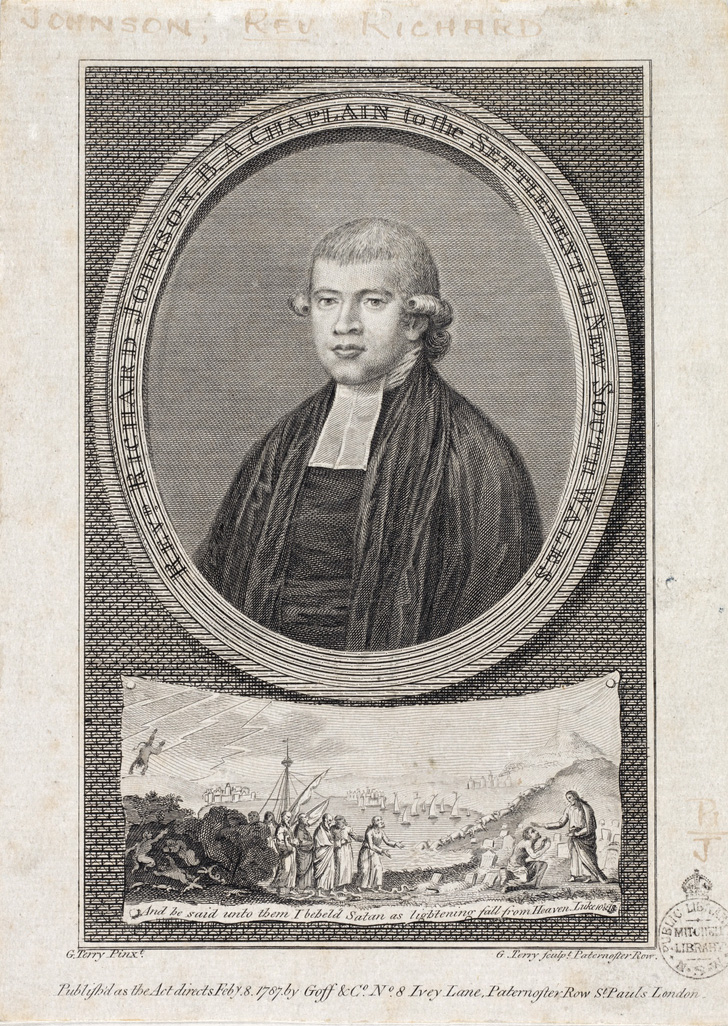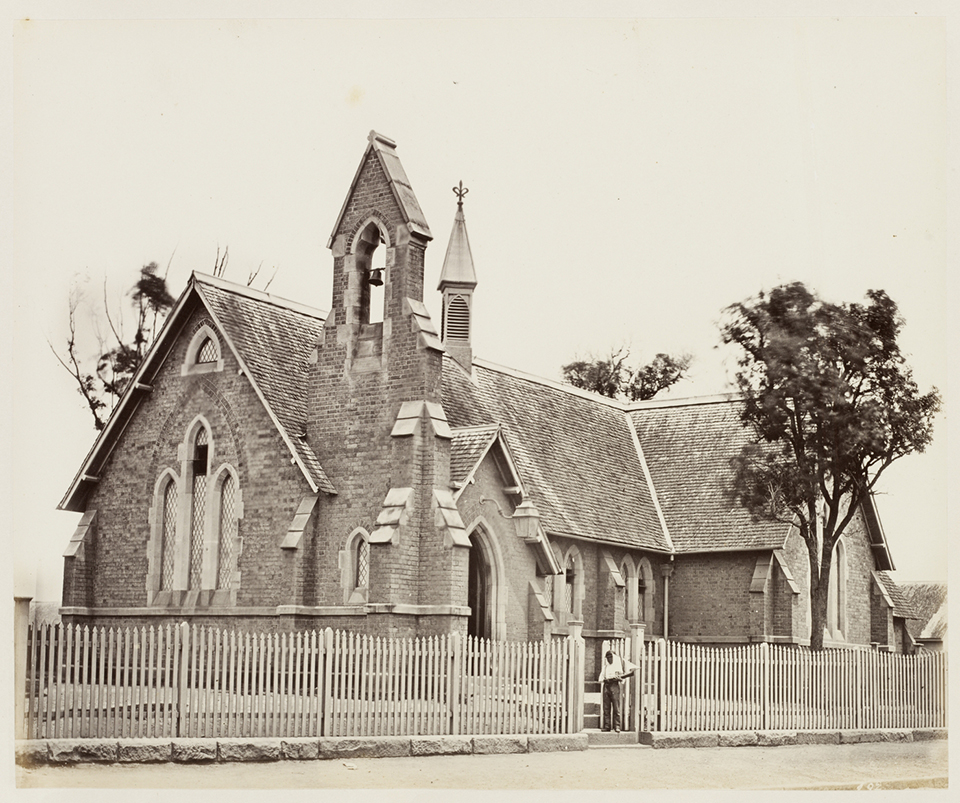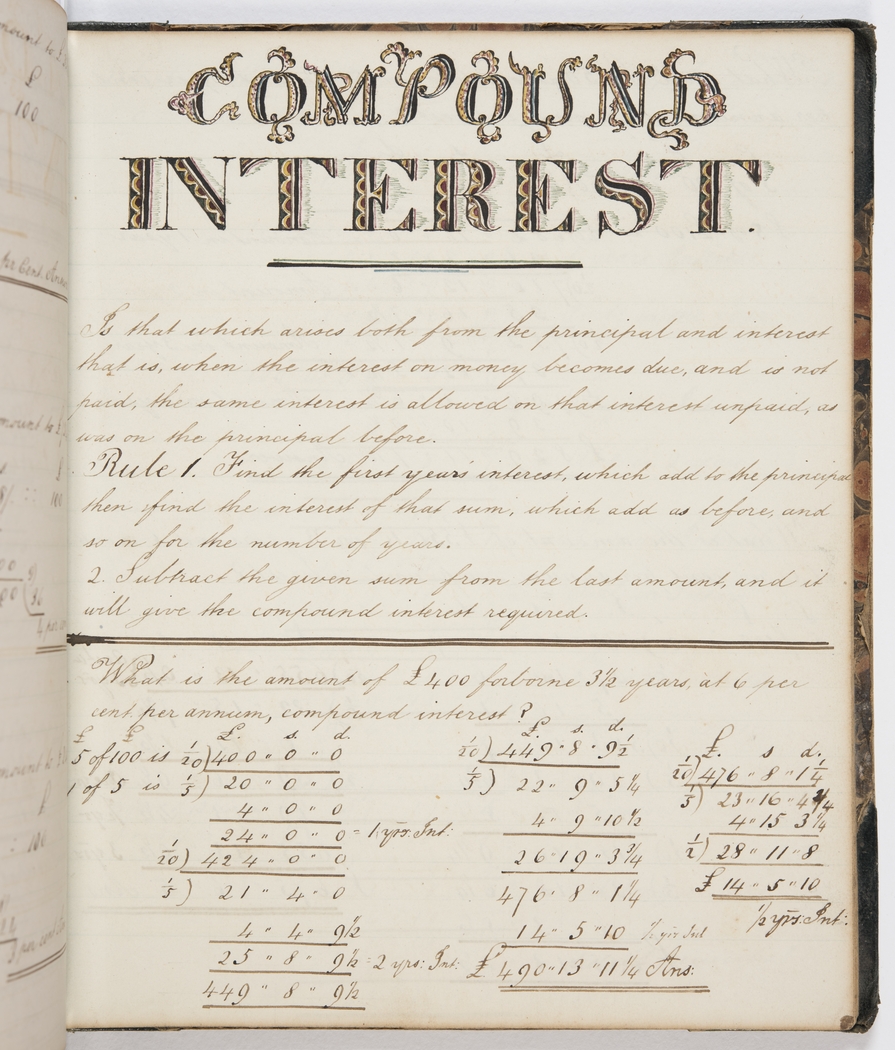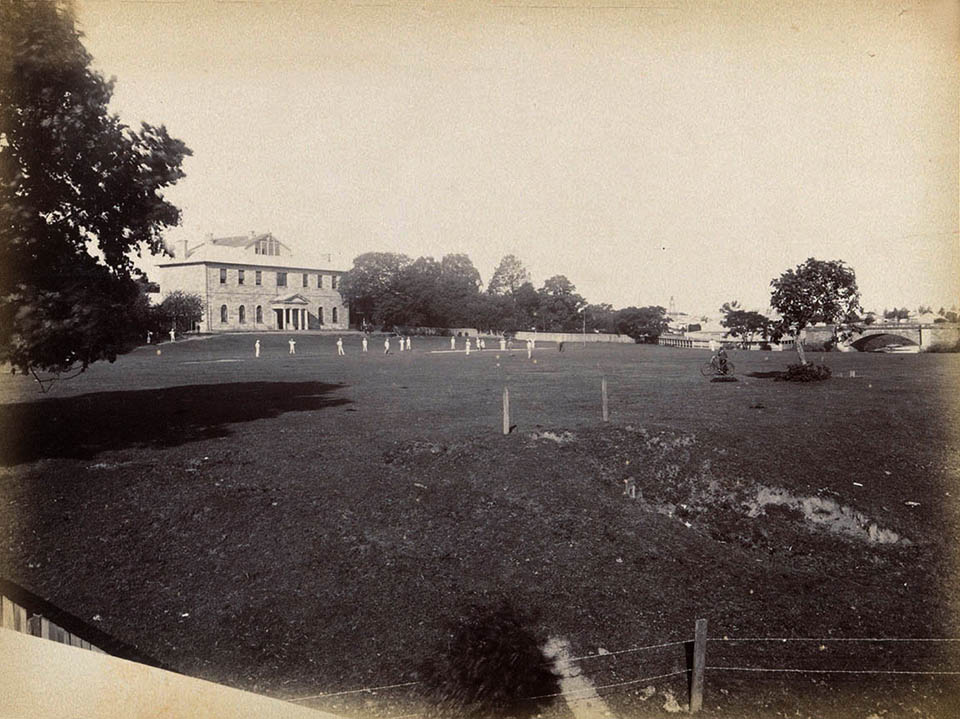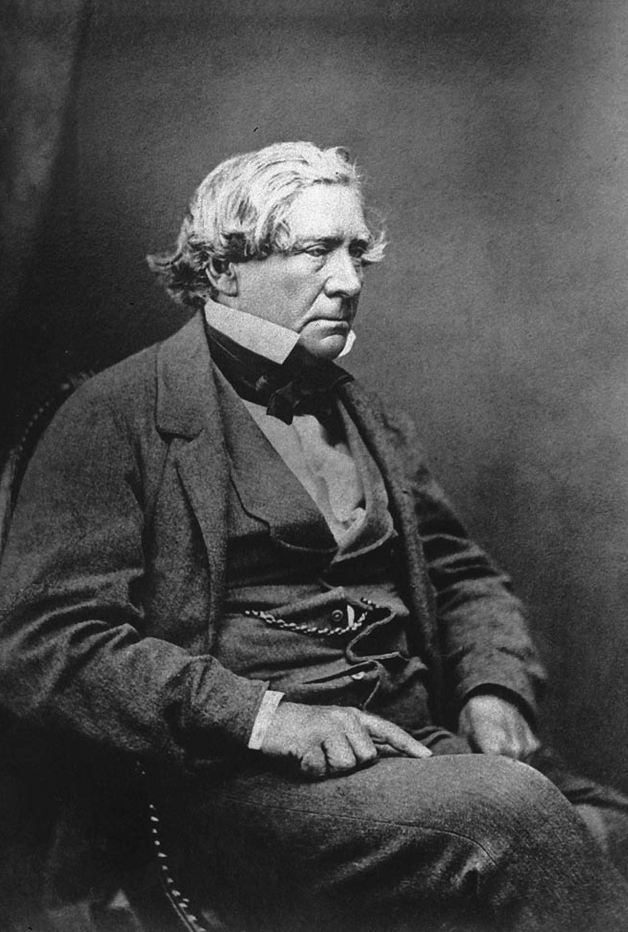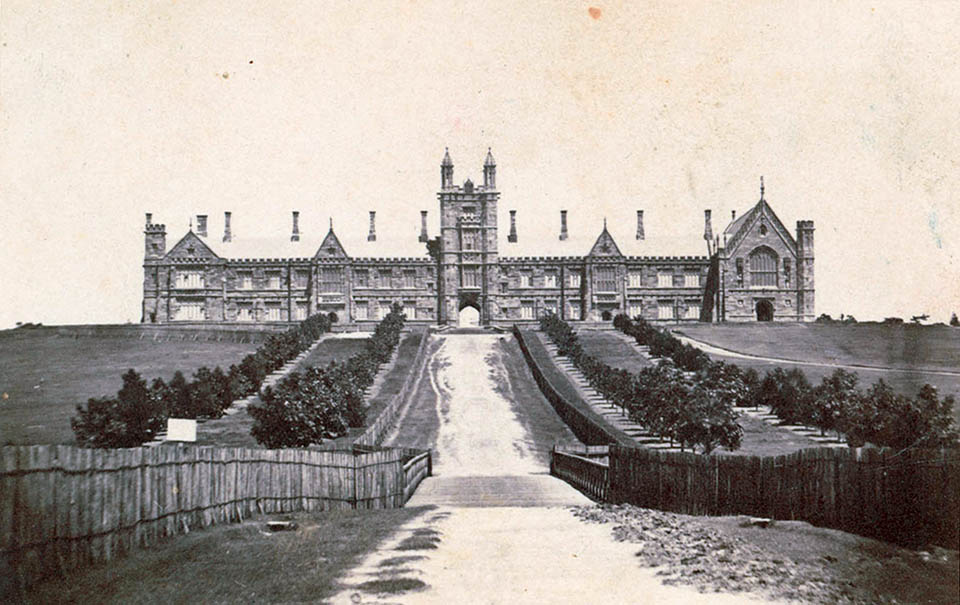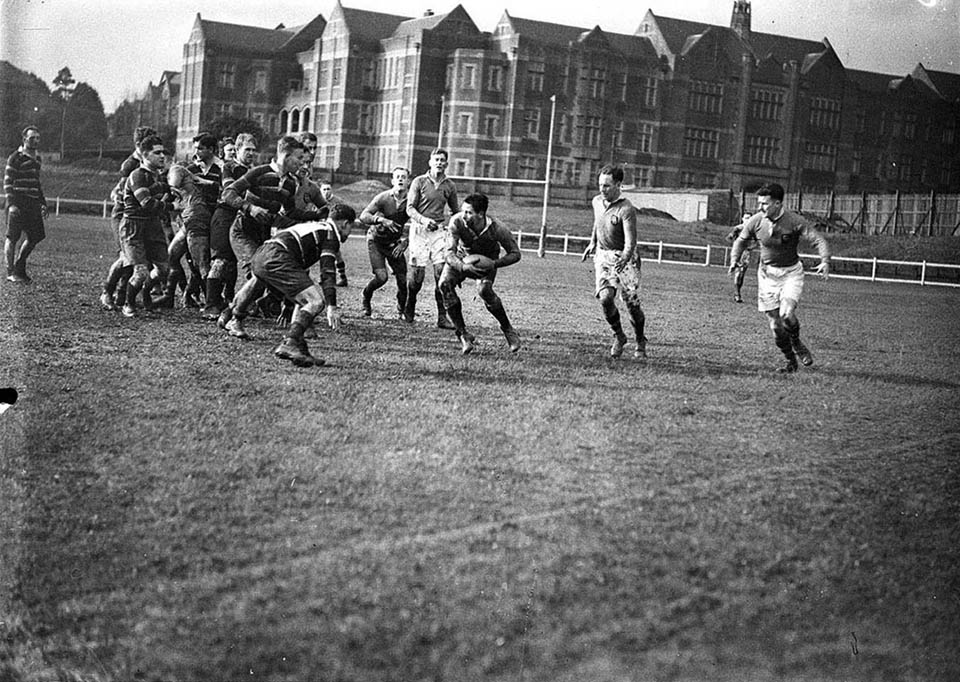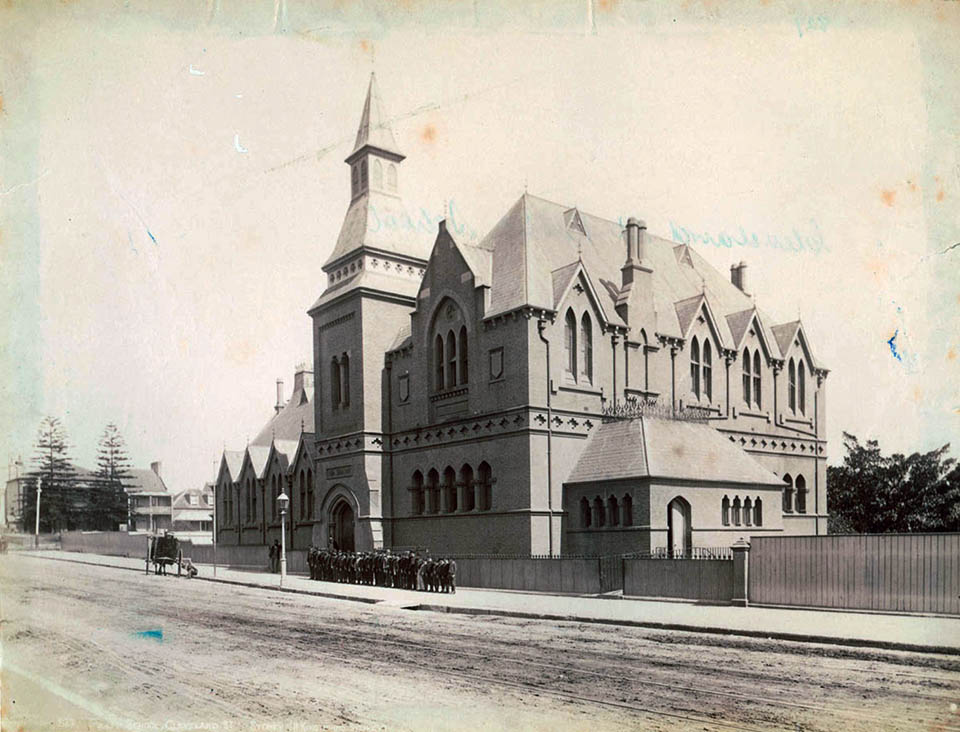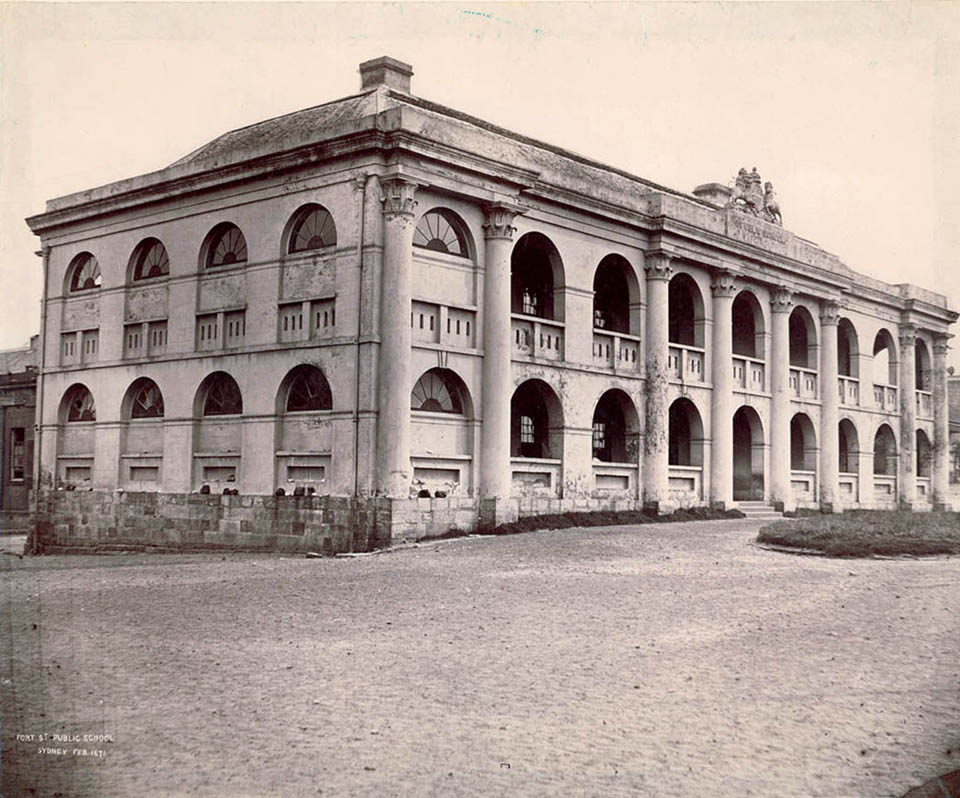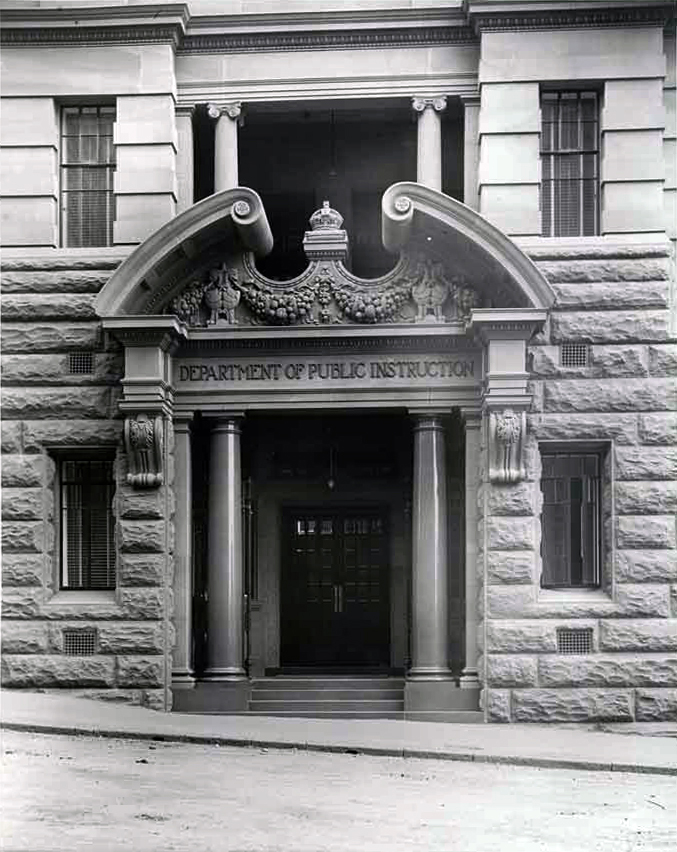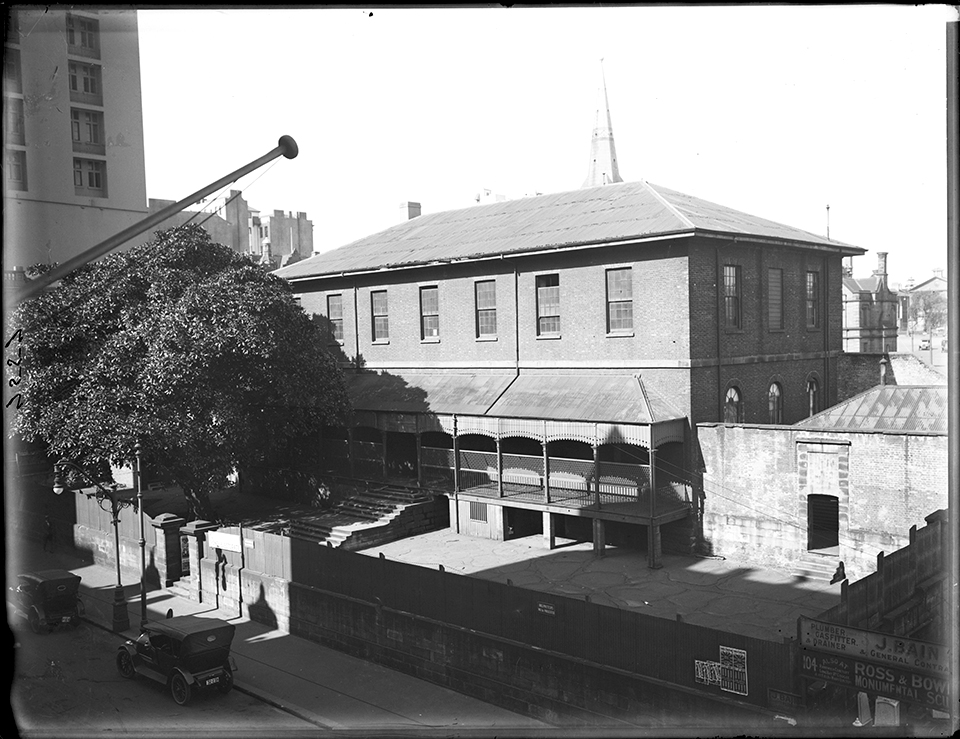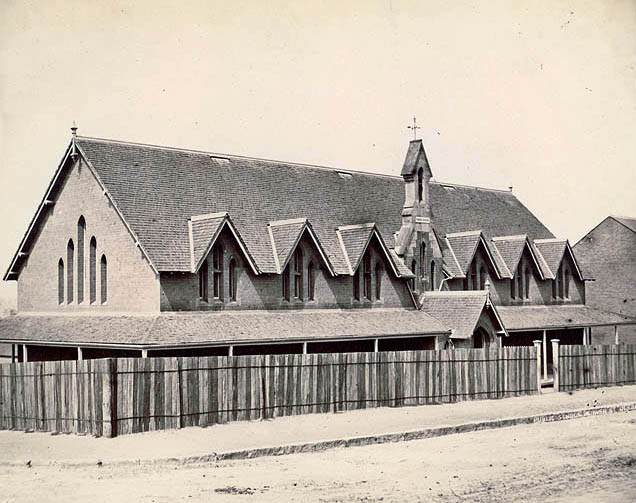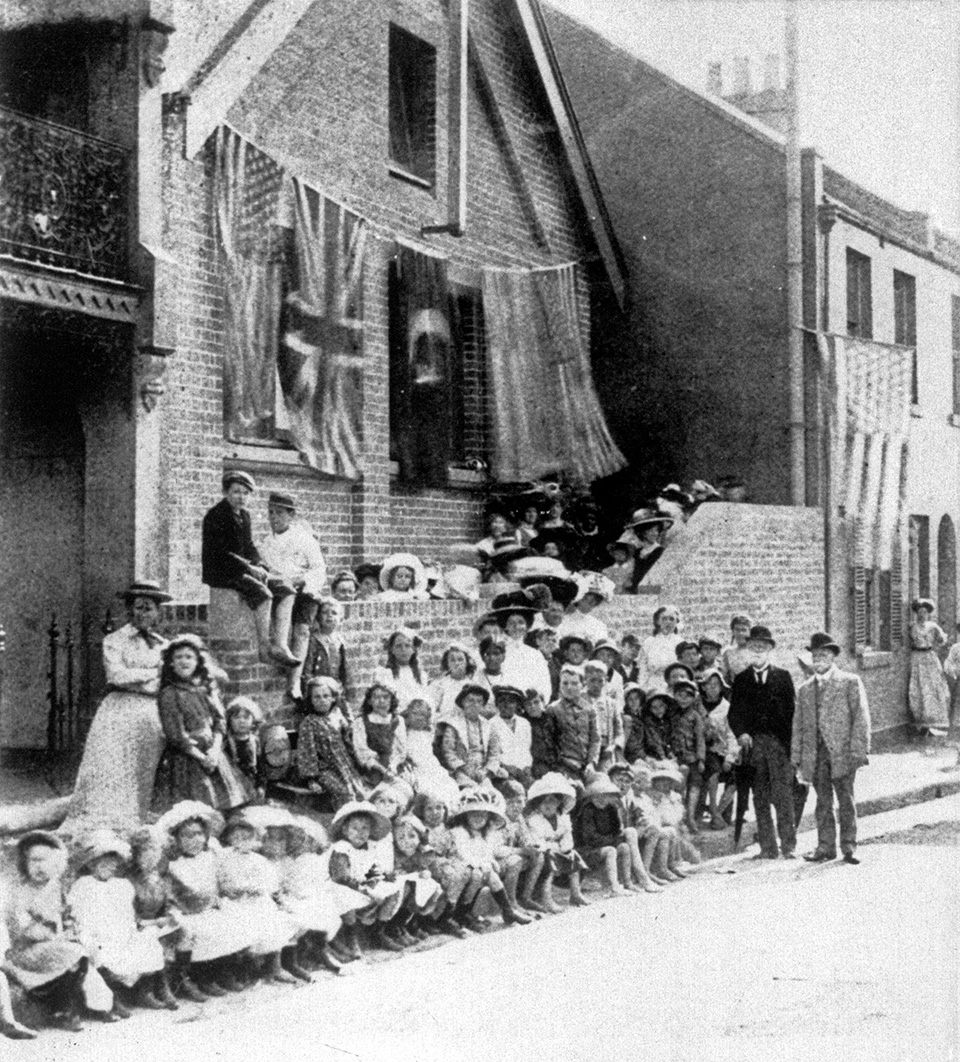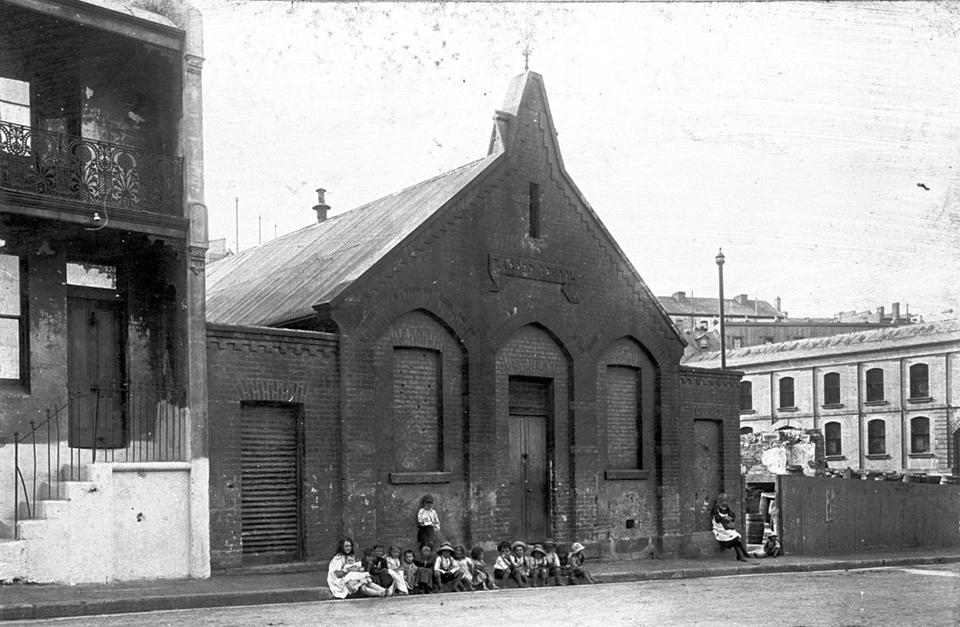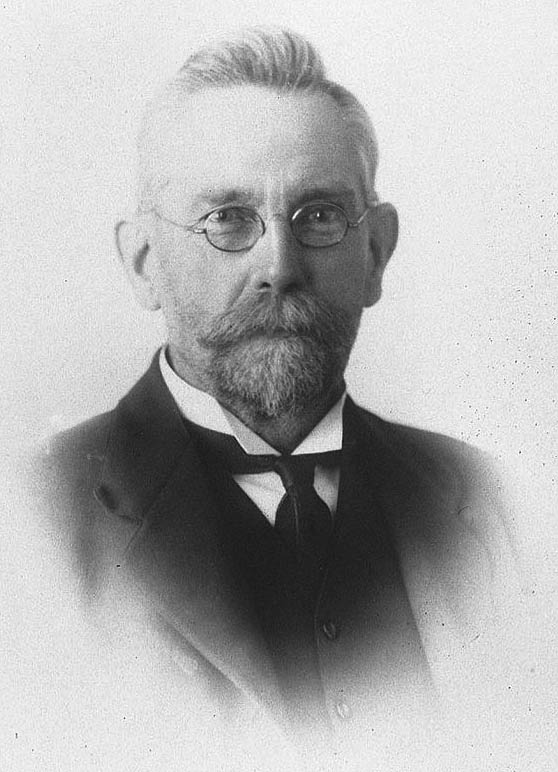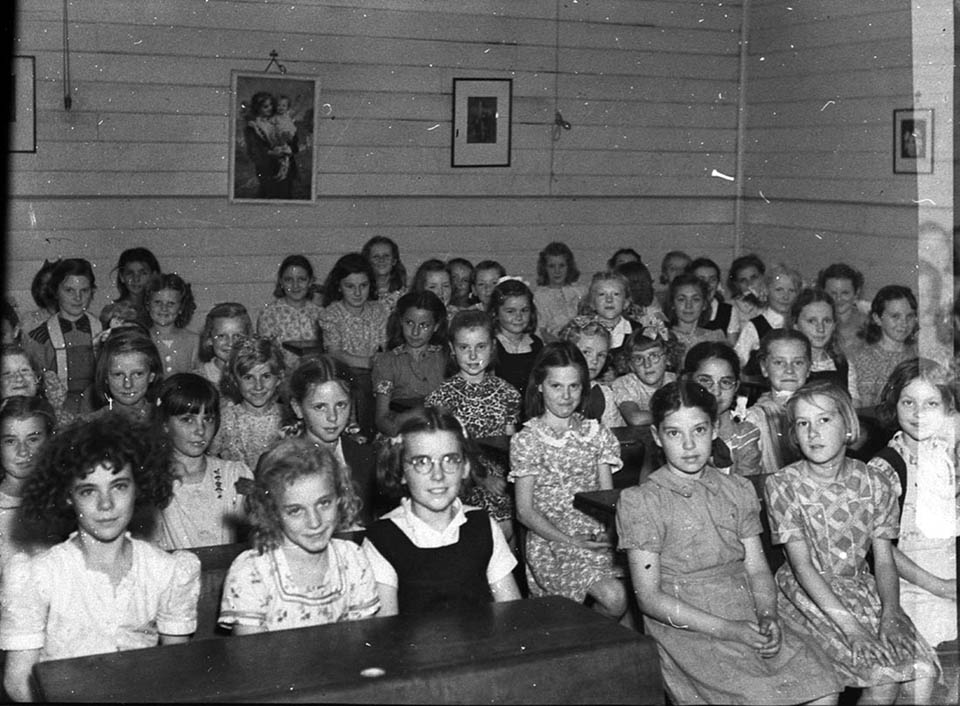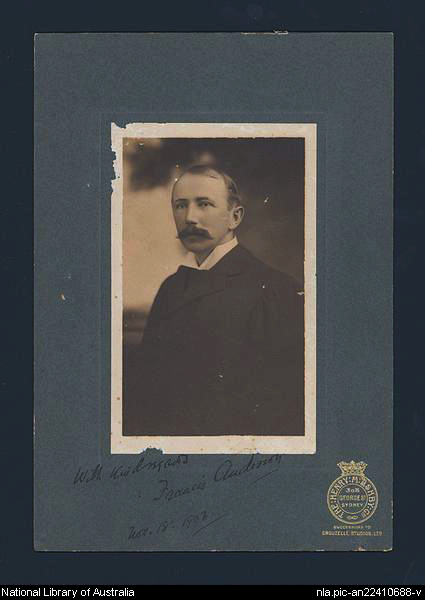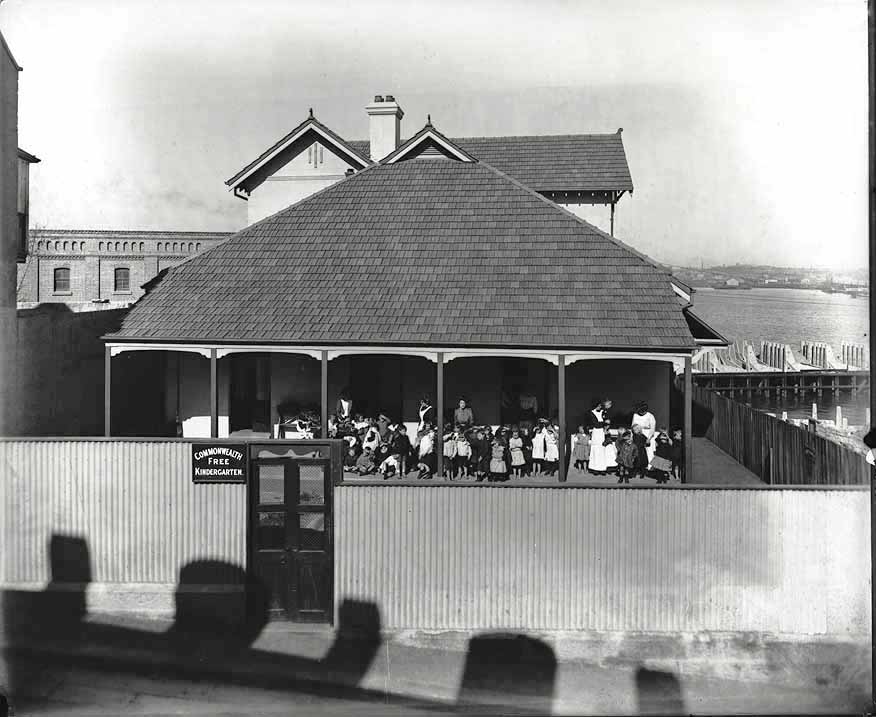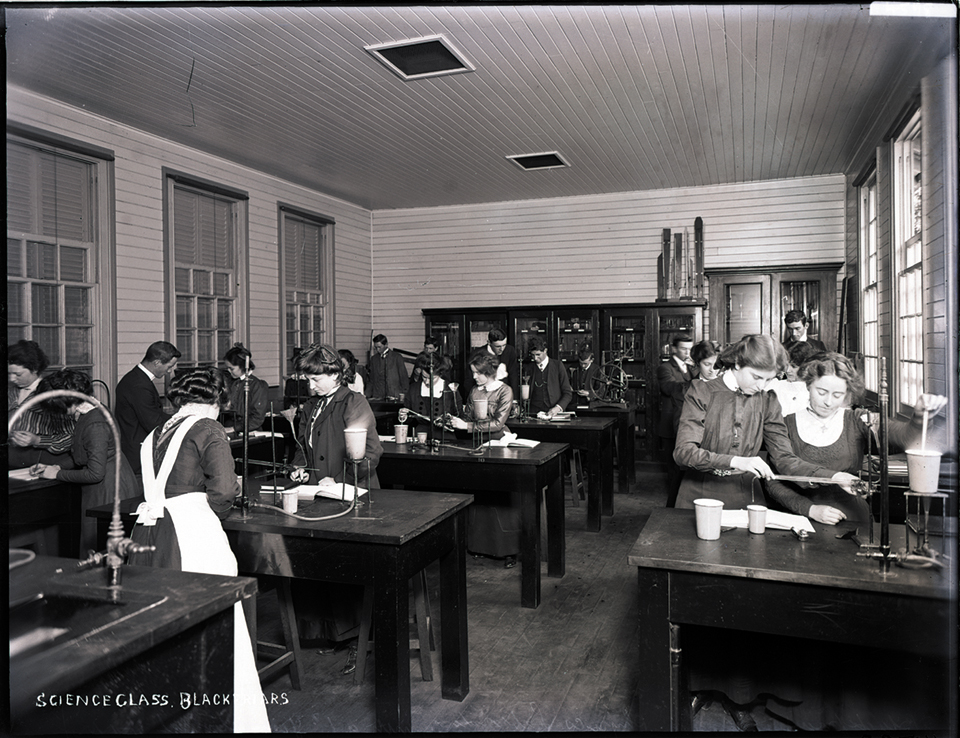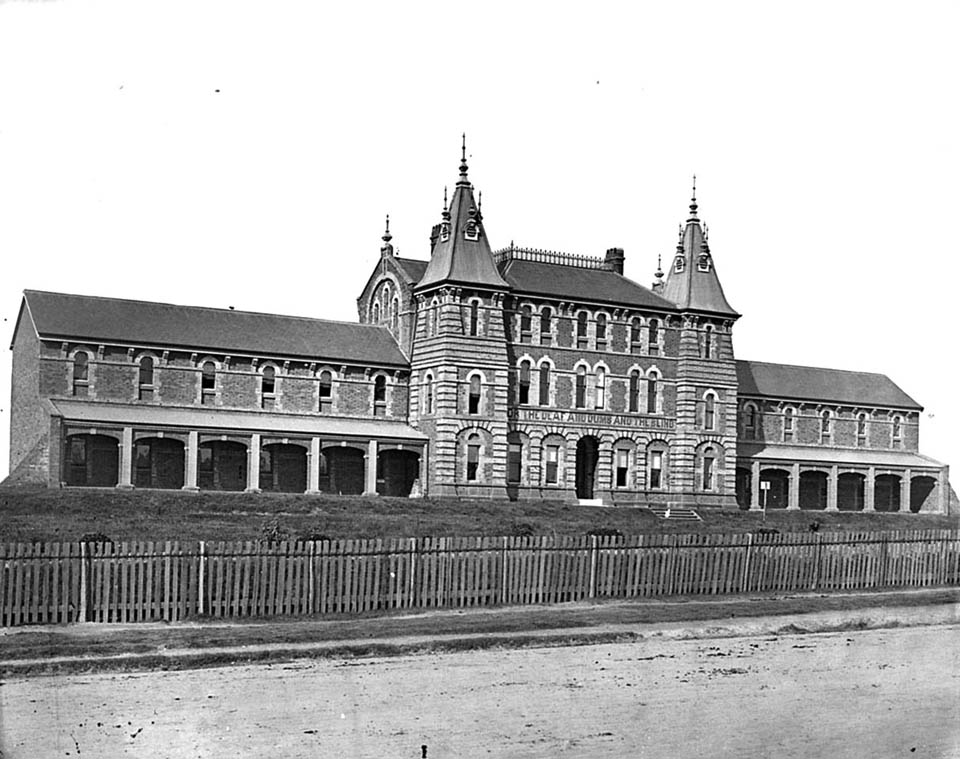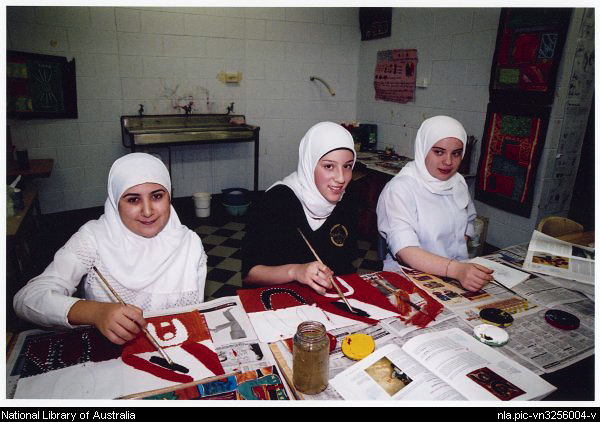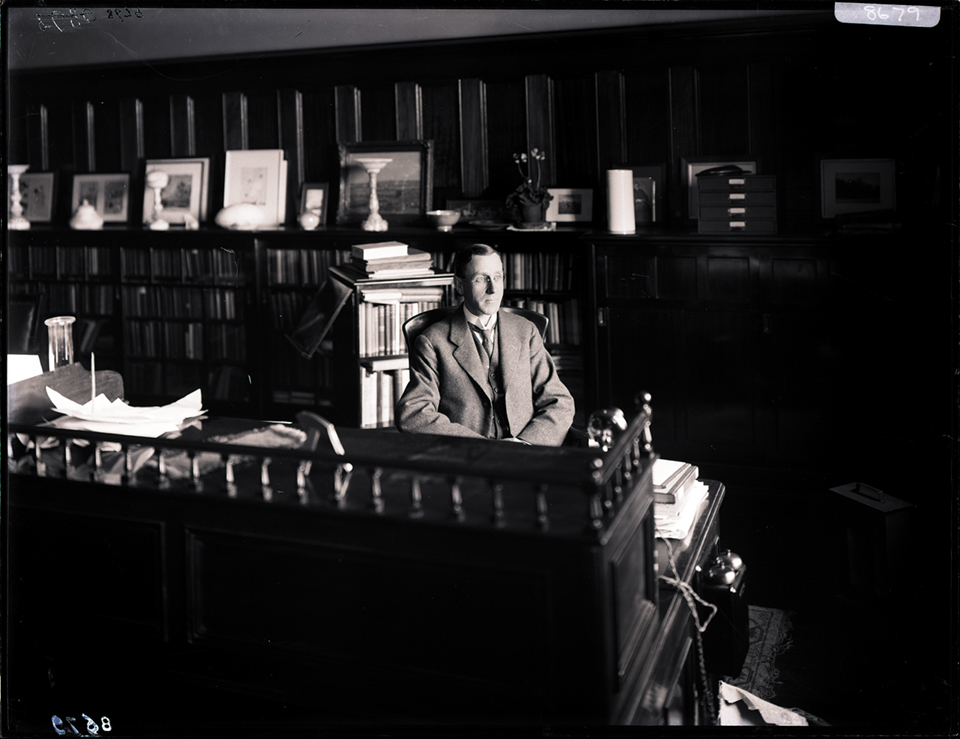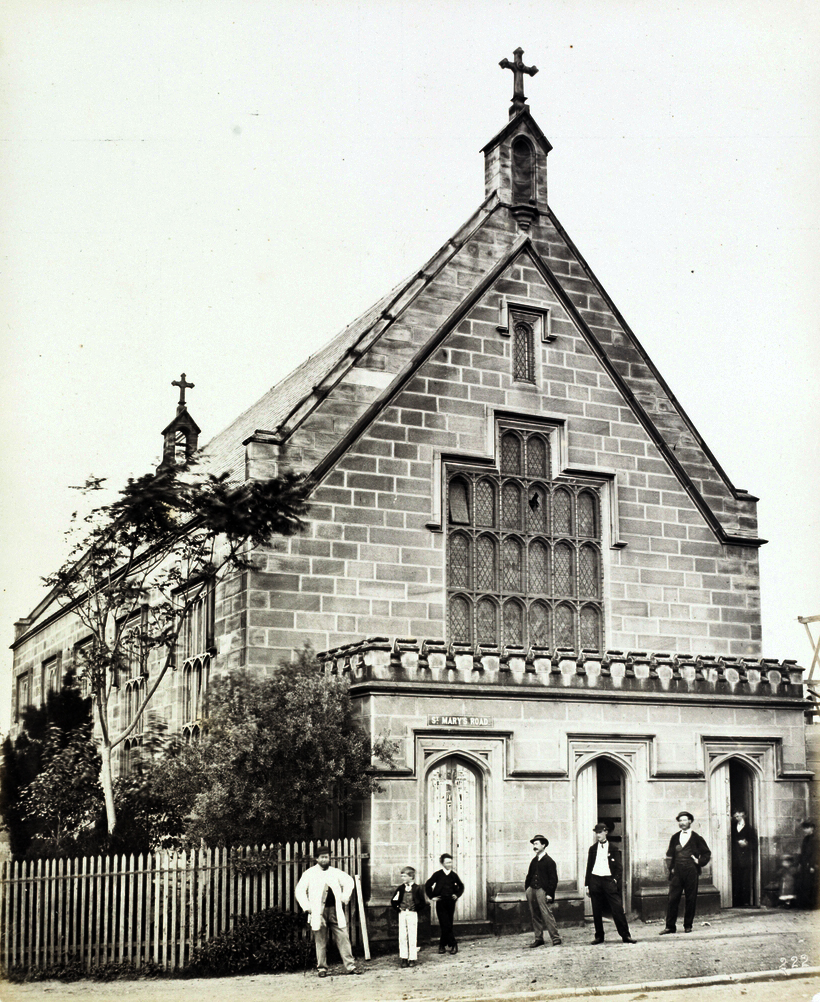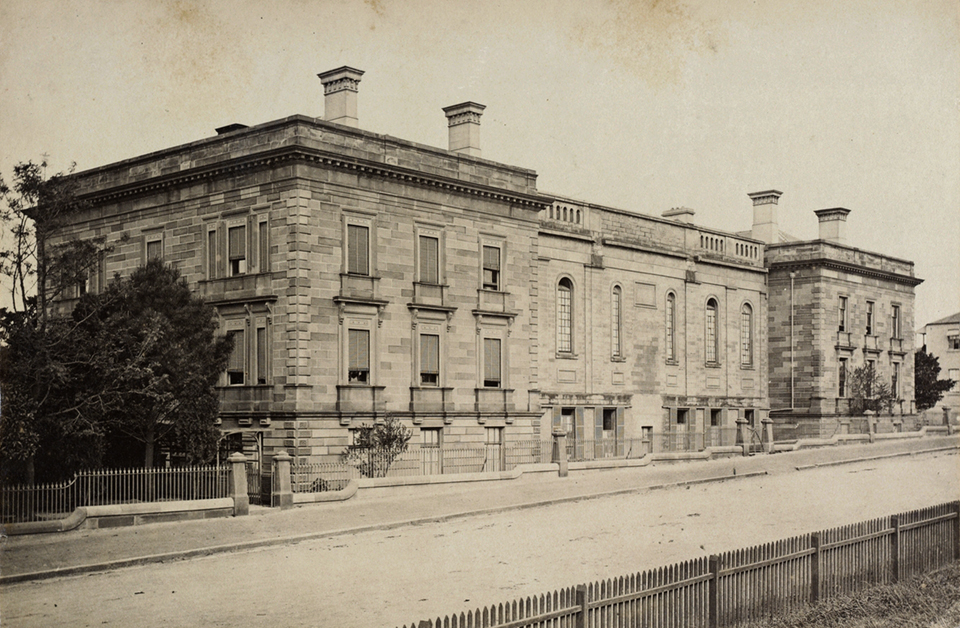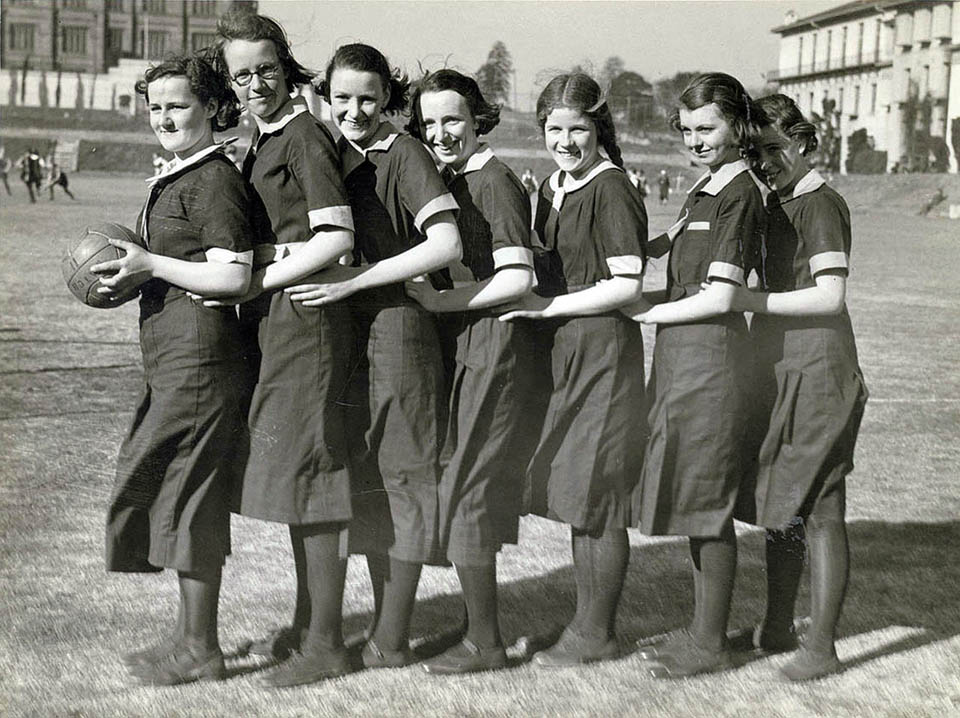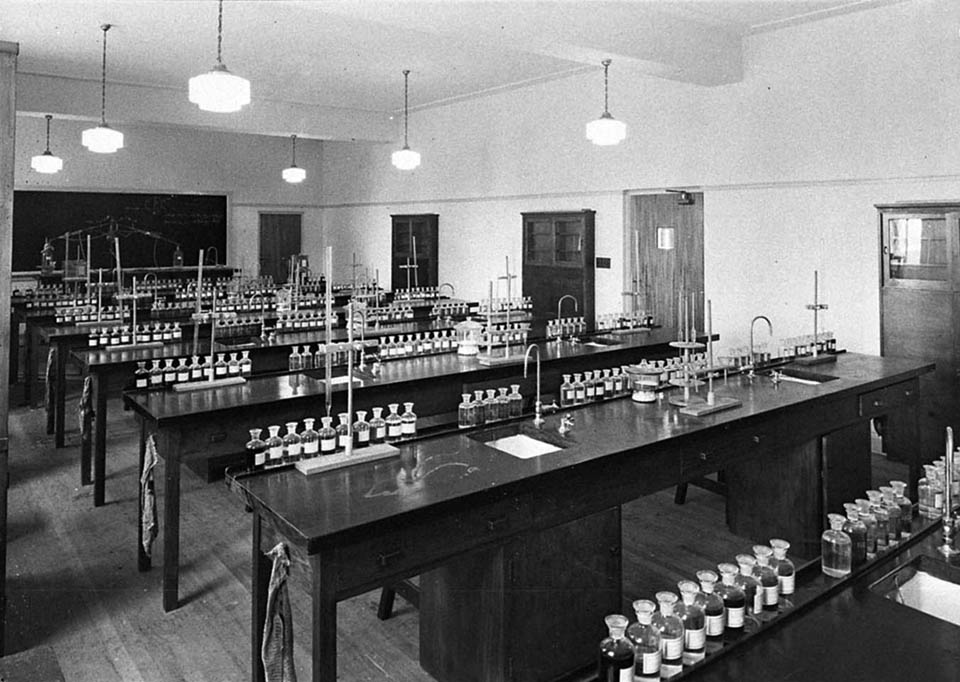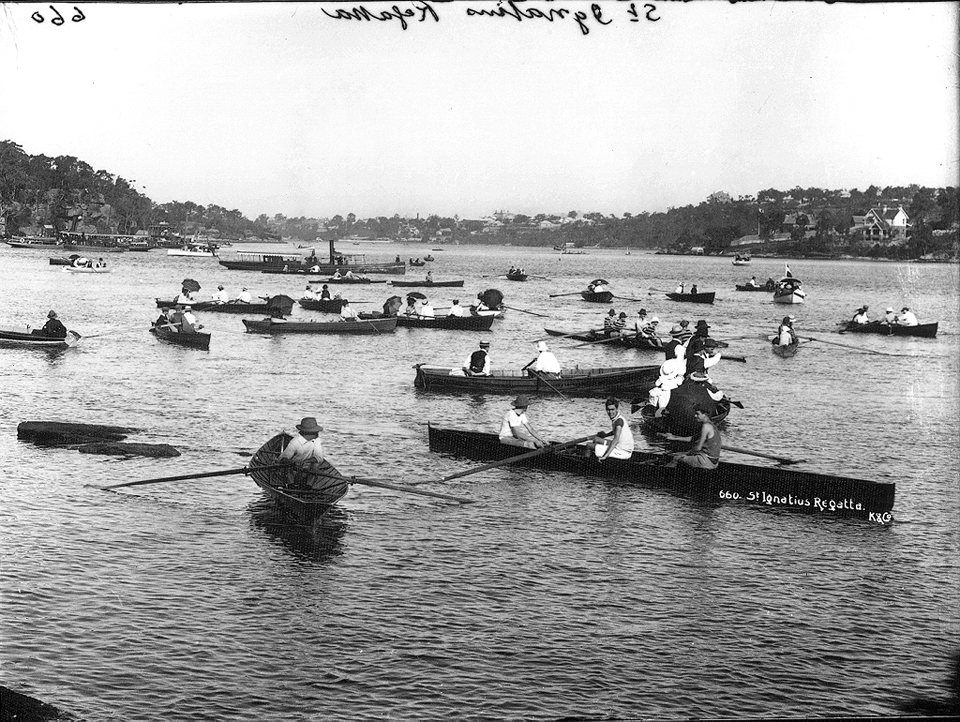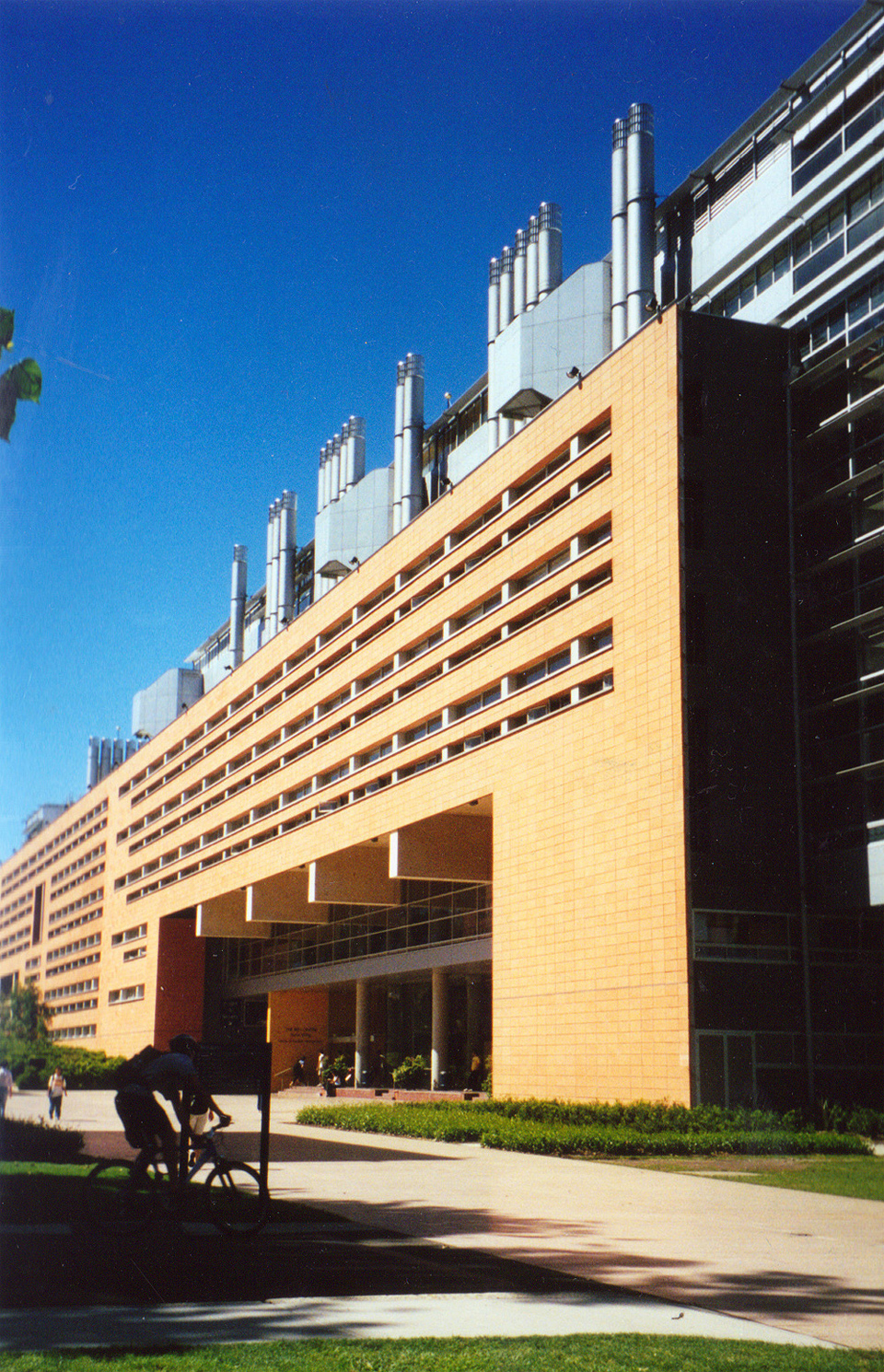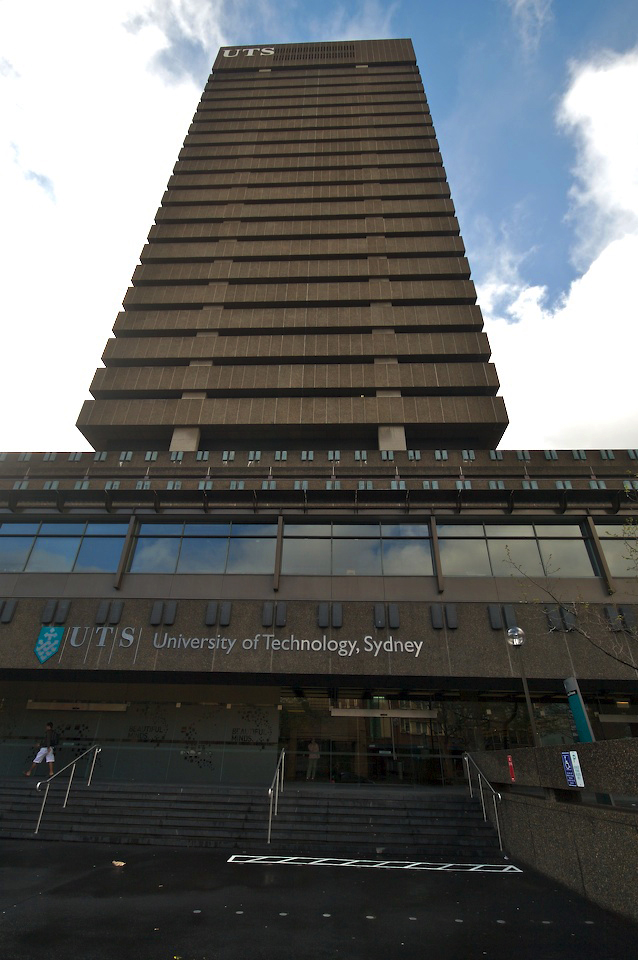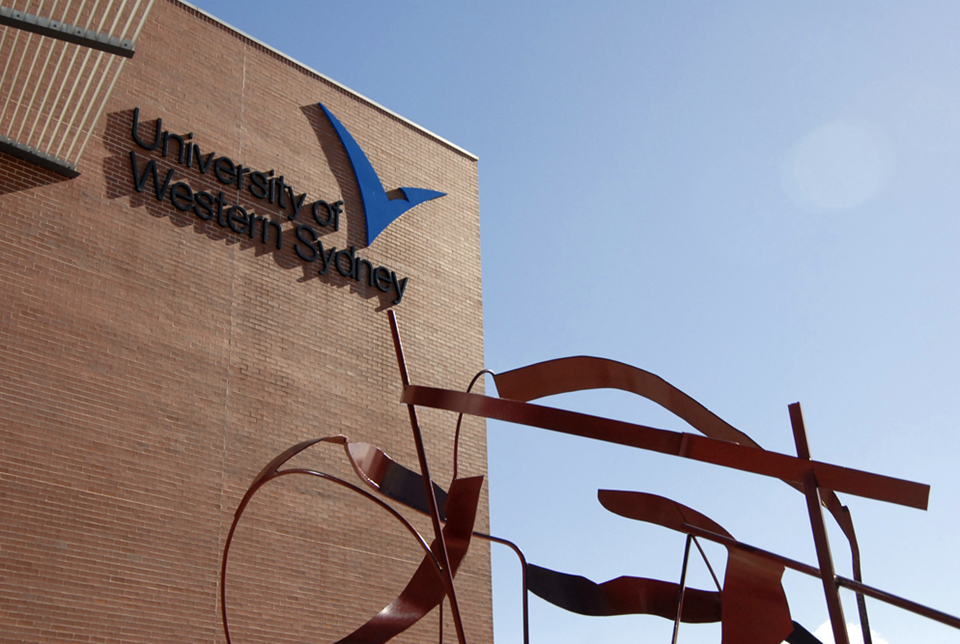The Dictionary of Sydney was archived in 2021.
Education
Citation
Persistent URL for this entry
To cite this entry in text
To cite this entry in a Wikipedia footnote citation
To cite this entry as a Wikipedia External link
Education
In the late twentieth century historians of education came to argue that the urban experience can only be fully understood through the social processes and social relations associated with schooling. The new 'social history' of education has thus often been closely aligned to the history of cities. [1] In Australia the 'new' social history of the city has often been written in terms of family formation, sometimes related to the history of childhood, but there has only been marginal attention to the specific nature of education in Sydney as an urban phenomenon. [2]
This essay focuses on Sydney schools and other educational institutions although it raises questions about social processes and social formations. It suggests that the history of education in Sydney can be understood in a number of phases and themes, each related to the changing social history of Sydney.
Informal education had long been part of the culture of Indigenous society prior to the British invasion of 1788. In the early colonial period, up to about 1830, governments established schools for the children of convicts based in Sydney and even for Aboriginal children. There were also 'private venture' schools for the sons and sometimes daughters of free settlers. [media]In the period from 1830 to 1870 the city of Sydney emerged as a metropolitan centre of educational establishments including schools, colleges and the University. From around 1870 to the end of World War II, with the growth of the city of Sydney and its suburbs, schooling was increasingly related to social class, gender and religion as part of suburban life. From 1945, the 'neighbourhood' school and even the 'local' university has become part of a pattern of regional differences associated with the expansion of the city through migration and population growth.
Colonial traditions
Learning was part of everyday life in the traditional Aboriginal society of the various peoples and clans of the Sydney basin. Children were brought up in a network of family and kin, engaging in both play and hunter-gathering activities. Ceremonies and formal initiations formed part of the life cycle as children matured into adults. As an important part of traditional culture, language developed through interaction with significant others. Other skills were learnt as part of a group. [3]
In contrast, the idea of modern institutionalised education was an 'invention' in Europe and Britain during the late eighteenth century. The first schools of the British settlers were concerned to foster the moral well-being of the 'rising generation' of native-born convict children. [media]The Anglican chaplain Richard Johnson established formal education. In 1797, the judge-advocate and secretary to the colony, David Collins noted:
There were at this time in the town of Sydney three schools for the education of children; and this being the period of their breaking up for the Christmas holidays, the governor was gratified with the sight of 102 clean and decently dressed children, who came with their several masters and mistresses, and in form paid their respects to his excellency, who examined the progress of the elder scholars in writing, specimens of which he kept for the purpose of comparing those with which they should present to him on the following Christmas. [4]
[media]So began in convict Sydney an educational tradition that would soon be exported to the rest of Australia – the colonial state would establish schools for the children of the poor or criminal class. Thereby, urban 'urchins' could be reformed by being instructed and tested in the basics of education.
There was particular concern with potentially disruptive populations. Following the example that he had established on Norfolk Island, in 1800 Governor King established an 'orphan' asylum and school for girls who were 'abandoned' by their parents (embracing more than one third of the female children then in Sydney). [5] This initiated the principle of removing children from parents deemed to be no longer fit to provide care. Education was thus closely aligned to both child welfare and social control. [media]By 1826 a Female School of Industry for girls had been established in Macquarie Street so that the inmates could learn 'useful' skills needed by household and farm servants.
The idea of schooling for care and control was soon extended to the Indigenous populations. Disturbed at Aboriginal acts of hostility and resistance towards British settlers, Governor Macquarie established in 1814 a Native Institution for the 'civilisation of these natives'. Both sexes were to be brought up in habits of 'industry and decency'. [6] The institution was later transferred to Parramatta but the experiment soon ended as Aboriginal children deserted the school to return to their families. So began a long series of failed attempts to involve the Indigenous young in formal education.
Religious involvement
As in Britain, the Christian churches became partners with the state in these endeavours, involved first as missionaries to the Aborigines and then in creating schools for the poor. Church engagement brought into being state aid for church schools as well as systematic forms of instruction. By 1824, land was reserved for the Church of England to provide funds for the establishment of a school system based on the monitorial instruction principles of Dr Andrew Bell of the National Society in Britain. Pupils were to be taught by a master teacher assisted by senior students acting as monitors and instructors. This provided the means for mass instruction of school populations. [7] The monitorial system never fully developed in Australia but it left as a legacy the idea that popular mass education could be bought 'on the cheap'.
[media]By the 1830s almost all the churches were seeking aid from the colonial state. Eventually, in the interests of efficiency as well as in the hope of religious harmony the state created its own 'national schools'. These were based essentially on the Irish National system of education which sought to teach a non-denominational but still Christian-infused curriculum. By 1848, there was a Board of National Education to administer these schools and a Denominational Schools Board to oversee the schools of the churches which continued to receive state aid.
Schools for the whole colony
In 1848 and 1849 there were 15 national schools established. Of these only three were in Sydney: Botany, Crown Street and Riley Street National schools. This fact reminds us that unlike the United Kingdom and the United States, the city and its wards were not the basis of government school organisation. The whole colony, and then the whole state was the focus of educational policy and administration. In effect, the colonial state set out to set up new schools in rural areas while the churches had established competing schools in the city. It was not until the early 1870s that schools of the government, known as public schools after the passage of the Public Schools Act of 1866, began to prevail in Sydney. As a consequence of this, it is usually difficult to untangle the history of national and public schooling in Sydney from that of New South Wales as a whole.
Associated with the new national schools were new forms of pedagogy and new ways of producing teachers. The notion of the 'pupil teacher' came to Sydney with the arrival of William Wilkins, the new superintendent of the Board of National Education. Himself formerly a pupil teacher, 'apprenticed' to a 'master' teacher and then trained for a period in a training college, Wilkins also established the idea of teacher standards and competencies, laying the basis for the slow emergence of the idea of teachers as professionals. [8]
[media]The pattern of education was different for the children of the few free and 'respectable' settlers in the Sydney region. From 1800, 'private venture' schools, sometimes conducted by clergymen but set up to make a profit, were being established in Sydney and Parramatta. While the teachers had little formal training, such schools offered a basic education in reading and writing, sometimes adding commercial subjects and even the classics for boys, and the 'polite accomplishments' of art and music for girls. [9]
The City of Sydney as the education metropolis
From 1830s to the 1870s most of the new and significant educational establishments of Sydney were created in or close to the city centre. The growth of Sydney as a commercial centre created a demand in the private sector for education from both new immigrants and emancipists. [media]One exception was The King's School, opened by the Church of England at Parramatta in 1832. Although founded on the English public school tradition, in its early years King's tended to cater for the small settlers along the Hawkesbury. [10]
The Church of England had tried to found another King's School in the centre of Sydney during the 1830s but this failed. The Roman Catholic Church was more successful with the opening of St Mary's College at the Cathedral site in 1837, transferring in 1852 to Lyndhurst at Glebe on the edge of the city. Focussing on a classical curriculum, Lyndhurst helped to create a Sydney Catholic middle class, some of whom became early matriculants to the University of Sydney in [media]1852. [11] [media]In 1858, the Sisters of Charity opened St Vincent's at Potts Point, now the oldest Catholic girls' school in Australia.
One of the early establishments taking its name from the city was Sydney College, founded by religious dissenters as a secular institution, and located in College Street on the site of the current Sydney Grammar School. Its first headmaster was WT Cape, who had previously run his own very popular private academy. Most students were the sons, aged from seven to 16, of the wealthy merchants of Sydney. [12]
[media]The Australian College, founded by the Presbyterian minister JD Lang, was in competition. The College offered a curriculum based on a Scottish model that included both classical and commercial subjects in accord with Sydney's commercial development. As Judge WW Burton of the Supreme Court pointed out, 'Nearly the whole number of pupils attended the classes for writing and accounts…' [13] It was an indication that vocational interests formed an important part of education in Sydney almost from the beginning of white settlement.
Other less formal institutions were still educational in purpose. In 1821 the Philosophical Society of Australia was founded in Sydney. By 1826 there was an Australian Subscription Library and Reading Room, the forerunner to the present State Library.[media] Finally, following the British model, Sydney Mechanics' School of Arts was created in 1833, ostensibly for the artisan, but providing a library for all classes, lectures and opportunities of enlightenment for all Sydney's citizens, including women. [14]
Founding a university
Many schools and colleges, including both Sydney College and the Australian College, failed during the depression of the 1840s, raising questions about the future of 'higher education' in Sydney. [media]At the same time, Sydney's leading citizens, such as William Charles Wentworth, were anxious to create an institution to provide social and political leadership founded on merit and not birth. Wentworth hoped the new University would challenge the Sydney establishment which had shunned descendants of emancipists, like him and his family, because of their convict heritage. [15]
[media]The new University of Sydney, established in 1850, was unique in the British Empire. A secular 'public' university, with a teaching and examining function, founded through state endowment, it owed nothing to any religious denomination. It had a 'social contract' particularly to serve its various 'publics' in Sydney. Sydney's male middle-class meritocracy who matriculated through examination, were the first to benefit. Many of them had access to generous scholarships. [16]
For a century it was Sydney's only university. While the original curriculum emphasised the classics, maths and science, the university soon developed professional 'schools'. It educated and formed the city's professions as well as the leaders in government and public administration. [media]It also influenced the city's cultural and social and sporting life. It soon became a nursery of cricketers in the city and colony as well as the virtual founding place of rugby in Australia. Until World War I, many sporting contests in Sydney revolved around the university. [17]
The university was also closely associated with adult education, first through extension lectures for the community and then through a connection to the Workers' Educational Association. Tutorial classes for the ordinary citizen began in 1913.
Colonial state education
The opening of the university created the need for a 'feeder school'. With encouragement from the University professors, the colonial parliament enacted legislation which founded and endowed Sydney Grammar School, opened in 1857 on the College Street site the university had just vacated. [18]
The establishment of the university and the endowment of Sydney Grammar School were indicators of the growing role of the colonial state in secondary and higher education. It was the same in elementary education. From 1848 the National Board of Education competed with the 'denominational schools' of the churches. By 1866 the old name of 'national' schools, associated with the now failed educational experiment in Ireland, had been replaced by 'public' from a local Australian perspective. It was a clear indication that the schools of the state, just like the university, were being designed to serve 'public' interests.
From the 1850s, colonial governments founded many solidly built Gothic-style public schools as a statement of commitment to civic pride and the common good. [media]Many were opened in the city and nearby suburbs. Such schools as Cleveland Street (1856) and Bourke Street (1866), both of which still stand today, were demonstrations of the authority and resources of public schools over the less impressive school buildings of the churches.
[media]At the peak of the public school system was Fort Street Public School, opened in 1850 just above The Rocks on Observatory Hill. Established as a model training school for teachers, Fort Street soon achieved outstanding results at the public examinations administered by the University of Sydney. Fort Street and similar state-provided schools became 'superior' public schools offering a form of secondary education for 'free'. [19]
With the universal male franchise came a clear view that education in a common school should be the basis of a common citizenship for most social classes. This was a challenge to the churches, particularly the Church of England and the Roman Catholics, who continued to maintain their own school systems with the assistance of state aid and in competition with the public schools of the state. While the church schools were often designed for the poorer classes, state administrators such as William Wilkins knew that many middle-class parents in Sydney had come to prefer the public schools as providing the 'best' education. [20]
[media]These issues came to head in the 1870s, culminating in the 1880 Act which removed all state aid from church schools and established a Department of Public Instruction. It was soon based in Bridge Street, Sydney, in a sandstone building that symbolised the civic virtues of public education. The Church of England agreed to give up its elementary schools (while moving more into establishing secondary schools) in the interests of common Protestantism. But the Roman Catholic Church rejected this settlement and condemned all public schools as 'irreligious' even though they still taught a form of non-denominational Christianity and allowed the churches some access. A great religious and cultural divide was created in Sydney, as in the rest of Australia where similar arrangements prevailed. Where you went to school almost mattered more than where or whether you went to church. Public schools had lay teachers; Catholic schools survived through having the 'religious' as teachers.
[media]In the wake of the 1880 Act, the colonial government established Sydney Boys' High School and Sydney Girls' High School in 1883 in Elizabeth Street on the site of the current David Jones store. The boys' school soon moved to Ultimo; the girls' school transferred to Moore Park, to be followed later by the boys. Many of the early graduates of Sydney Girls' matriculated to the University which had now begun to admit women. [21]
[media]From the 1870s, public schools began to spread beyond the inner city and nearby suburbs to appear throughout Sydney. In such areas as Summer Hill (1883) and Dulwich Hill (1885) or North Sydney (1874) or Sutherland (1887) the local public school occupied public space as well as creating a public image of a foundation of common citizenship.
[media]By 1914, enrolments in all New South Wales public schools had grown two and a half times since the 1880 Act. Much of this growth had taken place in Sydney. And in many Sydney suburbs with high Catholic populations, there also appeared schools attached to the local parish of the Catholic Church which had refused to accept the terms of the 1880 Act. With legislation to enforce school attendance, those born in the late nineteenth to early twentieth century became the first generation of Sydney children required to attend school until adolescence.
The public school and working-class communities
[media]The Public Instruction Act of 1880 made schooling compulsory for the first time, but there was a delicate balance to be struck between the state's interest in efficient schooling, and working-class communities' need for their children's labour. Well into the twentieth century children in working-class families were engaged in labour, often paid, of some sort or another. [22] It took a substantial time for working-class children in Sydney to become primarily 'school' children. The Public Instruction Act required attendance of no more than 140 days per year; this left plenty of time for absences for any reason – compulsory attendance was also hindered by the requirement to pay school fees. The building of a culture of schooling and childhood that assumed priority for the demands of the school on a young person's time over that of the family and their possible contribution to the household economy was not completed until after World War II. Among some Indigenous and other communities in Sydney, 'truancy', the new crime associated with not attending school, remains a problem.
[media]The future Director of Education Peter Board, when head teacher of Macdonaldtown Public School in the 1880s, was distressed by the conditions under which many working-class families in the area laboured. The attempt to enforce the payment of fees from the families compressed into nearby slum tenements led to multiple applications by him for the waiving of the fees. It was only in 1906 they were finally abolished by parliament. [23] It was not until 1916 however that the compulsory clauses of 1880 were amended. The new Public Instruction (Amendment) Act not only required schools to keep attendance registers, but virtually required all children in a public, Catholic or private school, to attend every school day. These changes, more than the 1880 Act, were more significant for transforming the attitudes of working-class families to the labour and schooling of their children.
The writer Christina Stead represents a somewhat jaundiced view of the culture of inner Sydney working-class schools in the early twentieth century in the novel For Love Alone (1945):
'I hate it, I hate it,' said the fair woman rocking herself. 'If I can only keep the kids down, I don't care if they never learn a line. That Milly Brown came in with a note from her mother again this morning about ink on her dress. I wish some of the mothers had to take care of my class for a whole day.'
'I wish that, too,' said Mrs Keeling. 'They'd wake up.'
Teresa burst out with: 'Why do you stay in it if you hate it so much? … .'
[media]The difficulties associated first with the Depression, then with World War II, meant that many public primary schools remained in straitened circumstances until the 1960s. In the 1950s the new emergency of the baby boom led to a prolongation of very large class sizes, inadequate buildings and inconsistent curriculum reform. Many Sydney primary schools and working-class populations of children in public and Catholic primary schools did not see large improvements until the period of the Schools Commission in the 1970s when federal funding was directed to such communities through schemes such as the Disadvantaged Schools Program.
The extension of the school leaving age from 14 to 15 in 1943 increased the pressure on the public school system to imagine suitable secondary schools for working-class children. For a time the system held with the reforms engineered by Peter Board as Director of Education from just before World War I. There would be technical schools for boys and home science schools for girls, and evening continuation schools for recent school leavers. They often offered commercial courses. Only clever working-class children were likely to achieve entrance into the academic high schools. Through the 1930s to the 1960s, intelligence testing was used to sort children, assisting in their selection for the different kinds of public secondary schools on offer in the Sydney metropolitan area. Such testing usually discriminated against working-class children. They were less likely to have access to the language and knowledge privileged by such tests.
New Education in Sydney
Curriculum reform along lines that imagined the child as potentially creative, more than a rote learner of facts, spelling and multiplication tables, was in the air from the late nineteenth century. Early manifestations of the New Education included the idea that one could learn better by doing – engaging with material or real problems in cooperation with fellow students. These ideas came mainly to Sydney from the United Kingdom. [24] Considerable effort was required to shift the educational establishment in Sydney however. At the turn of the century the tendency was towards self-satisfaction with the results of the Public Instruction Act and the bureaucratisation of curriculum, school inspection, teacher promotions and so forth. The challenge came from one of the professors at the University of Sydney. [media]In his 1901 address to a teachers' association meeting, Francis Anderson argued against schooling that conceived the process of education as systems and mechanisms. Neither the human spirit nor true learning was served by hundreds of children learning their geography like parrots: 'New Guinea – North of Australia – birds of Paradise – Gold.' [25]
The shock of the criticism led to various reports by GH Knibbs and JW Turner from 1902 on reforming education in New South Wales. Probably more significant was the work of Peter Board in rewriting the Primary syllabus for public schools. It certainly had a more liberal spirit than its predecessors, but there was a disjunction between the intentions of the syllabus and the realities of daily life in schools, and the ways that authority was exercised over teachers and the curriculum.
[media]A great boost to progressive education occurred towards the end of the Depression. The New Education Fellowship organised a remarkable travelling conference through the main cities of New Zealand and Australia, turning up in Sydney in August 1937. Its speakers from the United Kingdom, the United States and elsewhere demanded new approaches to assessment and examination, a redefining of the role of the teacher and the development of education for 'complete living' rather than narrow vocations and academic proficiency. [26]
These ideas would have more practical effect in Sydney's schools, government and non-government, after World War II, but an influential reform community in education had been formed. Sydney-born Harold Wyndham, the great proponent of opportunity classes, which are a distinctive and continuing feature of primary schools in Sydney, was secretary for the Sydney conference. He was later Director General of Education (1952–1968).
Preschools and special education
The new spirit that sought to liberate the body and mind of the child through active learning was most effective earliest in the education of infants. In Sydney the ideas of the nineteenth-century German philosopher Froebel were influential in the late nineteenth century, especially in private kindergartens for middle-class children. The New South Wales Kindergarten Union was founded in 1895, with a strong working-class reform mission. [media]The first free kindergarten was appropriately opened in Woolloomooloo in 1896. [27] Kindergarten classes were soon formed in public schools as well, although infants' schools as separate establishments had been opened in Sydney from 1880 to relieve pressure on crowded public schools.
Miss MM (Martha) Simpson was the most influential bearer of the message of Madame Montessori to Sydney. An early enthusiast, she persuaded the government to send her to Italy to learn first-hand. Arriving back in Sydney in 1913, Simpson 'plunged into a frantic round of interviews, talks and lectures …'. [28] [media]The teachers college at Blackfriars (Glebe) became the point of dissemination of Montessori-trained teachers and methods. The force of this period is still felt in Sydney today, though the preschools with the name 'Montessori' attached to them are more likely to be middle-class in character, contradicting the initial intentions of the new approach.
In Sydney there were other approaches to the care and education of the infant. The nursery school movement had its enthusiasts for a time, but the Kindergarten movement through its well-organised Union and training college prevailed.
The nineteenth century was a great age for the development of the social sciences and their application to the identification and management of populations that were thought either to be neglected, or a danger to the rest of civilised society. The development of confining institutions to deal with the young has already been referred to for the early part of the nineteenth century with the development of government-established orphan schools and the Native Institution. Later in the century attention turned to blind, deaf, 'dumb', criminal, retarded – and much later again, 'gifted and talented' children. A variety of public and private institutions were founded in Sydney, as ideas of what was a 'normal' child and the deviant 'other' were developed.
In 1866 two Acts were passed addressing some of the problem populations: the Industrial Schools Act and the Reformatory Schools Act. A Nautical School Ship for boys requiring reform operated in Sydney Harbour.[media] Three existing ragged schools in Sydney gained state assistance, along with the already aided Asylum for Destitute Children and the Deaf and Dumb Institution. [29] The summary of education in New South Wales written by Percival Cole of Sydney Teachers' College, and published in 1927, identified special schools for physical and mental 'defectives' as well as for 'moral delinquents'. Institutions he outlined for physical defectives included the Sydney Institute for the Deaf, Dumb and Blind. He thought that not enough was being done in Sydney for the physically disabled.
Cole was pleased that finally 'mentally-defectives' were being provided with special facilities. In the metropolitan area of Sydney he counted eight special classes, supervised by an expert psychologist. He looked forward with joy to the completion of a large residential school at Macquarie Fields for 'mental defectives'. It would be organised on the cottage system. The special classes would aim to give these young people sufficient skills to earn their own living. Cole argued that 'moral defectives' should no longer be treated as criminals. He was still happy with the 1901 Act that divided such children into two classes requiring separate institutional treatment. The first group of delinquents were 'genuine child criminals' who required reformatory schools. The second were neglected strays, requiring industrial schools and religious instruction. [30]
The recent changing politics, policies and institutions of special education are too complex to address here. Sydney was as responsive as other western cities to the calls for 'inclusion' and 'mainstreaming' and the closing of confining institutions in the late twentieth century. Nevertheless the demand for trained teachers to deal with special children, regardless of their institutional or social circumstances, remains strong. In 2003 the Department of Education and Training conducted some 106 schools for children with special needs, a large number of which were situated in Sydney. Children needing special schooling were identified by their 'intellectual disability', 'emotional disturbance', 'physical disability', 'visual disability', 'behaviour disorder' and more. [31] At least in language the non-normal child had begun to receive some dignity. 'Gifted and talented' children were usually in special programs running in ordinary government and non-government schools. Those who had convinced the state that they were academically able by sitting the selective schools test were in selective schools, or selective streams in mixed secondary schools. [media]Some non-government schools such as Sydney Grammar School and Malek Fahd Islamic School enrolled students on the basis of superior academic ability as well.
Teachers and teachers' colleges
The idea that teachers should be educated for their craft or profession is an old idea born partly in Sydney. Henry Carmichael had attempted to open a normal school, or training institution, in Sydney as early as 1834, in preparation for the intended introduction of the Irish national system of schooling. Both the early introduction of the system and Carmichael's school failed.
We have already mentioned William Wilkins coming from England to Fort Street Public School to assist in the training of teachers for the emerging public system. Fort Street played a significant role in preparing teachers in the late nineteenth and early twentieth century. [32] By the 1880s there was Hurlstone Training College for women. Nevertheless courses were short and the dominant models of teacher training continued to privilege apprenticeship through the recruitment of young people as monitors, pupil teachers and junior teachers. The idea that all teachers should be trained and credentialed in separate institutions such as teachers' colleges was slow to develop. Even at the beginning of the twenty-first century, New South Wales, unlike most other Australian states, had still not insisted that only teachers eligible for registration on the basis of specific teacher education, qualifications and experience should and could be employed.
Nevertheless the Department of Public Instruction was convinced that its army of public school teachers needed formal training. [media]In 1906 Sydney Teachers' College was established with a Scottish principal, Alexander Mackie, imported to lead the initiative. It collected its students from the Hurlstone Training School and Fort Street. That Mackie was simultaneously appointed a professor of the University revealed the development of educational thinking; that teaching needed to move from being a craft learned by apprentices to a 'science' learnt in lecture halls and laboratories. There was also the notion that teachers needed to be liberally educated people. Sydney Teachers' College lasted as a separate institution under the control of the Department of Education from 1906 until 1974. [33]
For teachers themselves, the struggle towards degrees of professional autonomy and acceptable remuneration and working conditions has been hard and long. In the process one of the more remarkable and powerful public teacher unions in the country has developed. [media]Based in Sydney, the New South Wales Teachers Federation has a significant voice not only in the working lives of teachers, but in education policy overall. It was one of the earliest teacher unions in Australia to affiliate with a Trades and Labor Council, and to adopt industrial campaign tactics in the pursuit of its policies. [34]
Catholic parish schools
[media]From the late nineteenth century the Roman Catholic Church throughout Australia built schools to emulate and compete with the public sector. Catholic elementary schools were closely tied to the local parish, and often located next door to the local church. And after the 1880 Act withdrew state aid to church schools, the teachers in Catholic schools were increasingly the 'religious' – orders of brothers and nuns founded overseas, often in Ireland, or formed in Australia. Without the religious as unpaid teachers, clothed in their habits, the Catholic educational endeavour would have failed. They also made Catholic education distinctive and very different from the public schools staffed by paid and trained lay teachers, many of whom were also Catholic. By 1883, the religious were already two-thirds of the teachers in Sydney Catholic schools; by 1950 they were 90 per cent. [35]
While following the general curriculum, set by the state through public education, Catholic schools came also to share a number of features. By choosing a Catholic school or college Catholic parents could be assured that their offspring would have the benefits of a good Catholic education: strict discipline, knowledge of Irish traditions, a highly gendered approach to making 'hard men' and 'good wives', and a commitment to continue the faith into the next generation. [36] And Catholic priests and the hierarchy in Sydney, as elsewhere, continually insisted that Catholic children should attend Catholic schools even though the majority remained in public schools until after World War II.
Many of the religious orders catered for the working class and poor in Sydney. The Marists may be best known for the more exclusive St Joseph's College at Hunters Hill, founded in 1881, but they began in the inner city parish of St Patrick's in the Rocks where they maintained a presence until the 1960s. [37]
Gradually, Catholic parochial schools in Sydney became part of a system. Subject to state registration, and with their pupils sitting the public exams, there was soon a Catholic inspector of schools while many of the religious orders created their own training colleges. By 1939 there was a 'Catholic Education Office', initially just a room in Roma House in George Street. [38] But more coordinated administration could not prepare Catholic schools for the postwar bulge in student numbers when many nuns and brothers had to cope with classes of up to 100 in size.
Corporate schools in the suburbs
From the mid-nineteenth century, all the churches as well as other bodies were founding secondary schools within emerging middle-class suburbia. In Sydney now, these are usually called 'private' schools to distinguish them from the 'public' schools of the state. But they were different from the 'private venture schools' which were still owned and run by clergymen and university-educated women in Sydney well into the twentieth century. Historians of education call these schools 'corporate', as they were usually founded by corporate bodies such as the churches, and by religious orders in the Catholic Church. Most had formal constitutions, were governed by corporate bodies such as appointed or elected councils, and sought to develop a corporate image and ethos.
These schools helped to solidify the patterns of class-related difference in employment and living arrangements that developed in Sydney's suburban development from the late nineteenth century. The corporate model was founded on the English public school tradition with its emphasis on character formation and social distinction. As in Britain, schooling in Sydney thus became an important way of establishing social rank, particularly for the 'old middle class' of business and professional families. Corporate schools were designed for students to learn how to lead. [39]
[media]A few corporate schools remained in the city centre, such as Sydney Grammar School which now found itself restricted for growth and expansion of facilities. The most significant corporate city school foundation of the late nineteenth century was Sydney Church of England Girls' Grammar School at Darlinghurst (1895). Other corporate schools developed in the middle-class suburbs along Sydney's growing rail network line from Parramatta or in the eastern suburbs with the subdivision of the old holdings such as the Cooper Estate.
Perhaps the best demonstration of corporate schools in the suburbs came on the North Shore. Initially educational development along the North Shore began at North Sydney, close to the harbour. [media]Here could be found the Catholic girls' school Monte Sant' Angelo (1875), the Catholic Jesuit boys' school St Aloysius (1879), Wenona, a private school that became corporate (1886), the Church of England boys' school soon known as 'Shore' (1889) and then the Catholic girls' school Loreto Kirribilli (1907) .
[media]The continuation of the North Shore railway line south from Hornsby brought the creation of corporate schools on the 'upper' North Shore, some of which were church foundations, and some of which were church takeovers of existing private venture schools. Abbotsleigh (1885) was a girls' private school later taken over by the Church of England. Barker College at Hornsby was a private foundation in 1890 but was later taken over by the Church of England. The Catholic girls' school Loreto opened at Normanhurst in 1897. Ravenswood (1901) was a private girls' school at Gordon that subsequently became Methodist. Presbyterian Ladies' College at Pymble (1916) and the Knox Grammar (1924), a boys' school at Wahroonga were later examples.
Locality and social class often coincided. Throughout the early to mid-twentieth century almost two-thirds of the students at Shore came from homes on the North Shore while a quarter were from outside Sydney. [40] Almost all of the corporate schools provided for 'boarders from the bush', and for the social elite such schools served as links between city and country.
[media]Beyond the usual reaches of train and tram, other corporate school were established in bush settings. Perhaps the most important of these were St Ignatius College, established by the Jesuits at Riverview on the Lane Cove River (1880), and St Joseph's College (1881), founded by the Marist Brothers at Hunters Hill. With its place by the river, St Ignatius soon became a site for regattas and rowing contests.
The establishment of the corporate boys' schools of Sydney led to the formation of the Athletic Association of Great Public Schools, representing the seven most significant corporate schools – King's, Grammar, Newington, Shore, St Joseph's, St Ignatius and Scots, as well as the public Sydney Boys' High School. [media]Their organised contests in cricket, rugby, athletics and rowing soon became part of the Sydney social scene, with the 'Head of the River' regatta a highlight of the social calendar by the 1920s. [41] In such ways, suburban and school life merged to become part of the patterns of leisure and pleasure of middle-class Sydney.
There were a few departures from the norm with the establishment of progressive or alternative schools for the small cosmopolitan middle class of interwar Sydney. Influenced by overseas educational progressivism Morven Garden School opened at Mosman in 1918. [media]This social experiment, under the Americans Walter and Marion Griffin, eventually brought Anthroposophy to Australia and led to the foundation of schools influenced by the German Rudolf Steiner. [42]
The spread of public high schools
Sydney's corporate schools, while influential in social class relations, were far less dominant than similar schools were in Melbourne. [43] In Sydney, a selective academic high school tradition was established as part of the reforms of Peter Board in the early twentieth century.
Public high schools catered for the 'new middle class' – often in public sector employment – who sought academic qualifications for their children. As with the corporate schools, state secondary schools in Sydney were all single sex. Only at Parramatta was a coeducational school established, in keeping with the principles for all non-metropolitan schools in New South Wales. [44]
[media]Selective academic high schools soon cemented their status through the competitive Leaving Certificate examination. The most famous was Fort Street, building on its established nineteenth-century reputation. Under its legendary headmaster, Kilgour, Fort Street soon acquired a reputation for producing future lawyers, doctors and other professionals. [45]
Analysis using Who's Who suggested that of the elite born in New South Wales before 1945 (most of whom would have been born in Sydney) more than 55 per cent had been educated in selective public high schools, only 30 per cent in corporate schools and about 15 per cent in Catholic colleges. And three public boys' high schools – Fort Street, Sydney Boys', and North Sydney Boys' – produced one-fifth of the social elite. [46]
While certain elite high schools were most prominent, public high schools grew up throughout Sydney's suburbs in the period up to the 1950s. And, unlike Melbourne, many of the new high schools were in lower middle-class or even working-class suburbs. [47] Thus Fort Street boys moved to Petersham in 1905 while the girls remained behind in the site on Observatory Hill. North Sydney Girls' High (1914) and North Sydney Boys' High (1916) were established in an area that still had a working-class population.
The best-known public high schools attained prestige by drawing students from across the city. There was also a ranking which placed the elite schools such as Fort Street above the 'second rate'. Sydney Technical High School opened as a boys' high school at Paddington in 1913. By the 1950s Clive James found it 'run down', mediocre, very inferior to the nearby Sydney Boys' High and not even focussed on technical studies. [48]
In some ways the public high schools were like the corporate schools, adopting some of their 'machinery' of school governance and identity such as prefects and school colours. [media]The boys' schools had a similar passion for sport. But the academic tradition in education was maintained more in the public sector than in the private. And certainly, the 'Fort Street factor' was not found in any other Australian capital city to the same degree
The postwar comprehensive high school 'revolution'
Growth and then diversity marked much of the early postwar pattern of schools in Sydney. As early as 1947 the state Department of Education had been divided into administrative regions to cope with the complexity of governing public schools. Ideas of postwar reconstruction followed by emerging social pressures of postwar prosperity led to demand for more places in secondary schools and then in universities. As a result, in the public sector the differentiated system of selective academic high schools and post-primary schools was increasingly replaced by a new universal system designed to become the 'wave of the future'.
By the late 1950s, Sydney had become the focus of an American-inspired 'educational revolution' in the organisation of state schooling. Following the report of the Committee chaired by Dr Harold Wyndham, Director General of Education from1952, who had been influenced by American ideas during his postgraduate studies at Stanford, government public high schools became comprehensive in nature, enrolling all students in the local neighbourhood. The new system was designed to replace the early selection of students for different schools that had prevailed since the early twentieth century. A few boys' and girls' high schools in Sydney, including Fort Street, remained selective as a result of pressure from former pupils and others. [49]
For most of the 1960s and 1970s, and even into the 1980s, the opening of new comprehensive high schools to accompany suburban expansion was the major educational phenomenon in Sydney. The comprehensive school was associated with the idea of 'neighbourhood', suggesting a close relation between a school and its local community. In effect, the introduction of comprehensive schools took on a different shape in different parts of the city. In the 'inner city' it meant reorganisation of existing junior technical and home science schools. In the outer west and north-western regions, on the northern beaches and peninsula, or in the Sutherland shire, new comprehensive schools were purpose-built. In western and south-western Sydney, some saw the comprehensive school as an agency of assimilation, enrolling boys and girls in the same schools and taking in the waves of different ethnic groups who were arriving in the city. [50]
The comprehensive schools were a direct challenge to the private sector, and particularly the Catholic schools which were now under intense pressure to survive. But within a few decades all this had been reversed.
Funding and the drift to private schools
In 1945, state governments provided schools to the vast majority of pupils. Various faith-based and other schools catered for the rest but without any form of state aid. Within 30 years, federal and state governments had begun to provide funds to the private sector, helping to initiate a new era in the history of Sydney schools.
During the 1960s, there were haphazard forms of state aid, including subsidies for costs of transport to schools and federal government grants for science labs and libraries. But systematic forms of federal government aid to both public schools and private schools began with the establishment of the National Schools Commission in 1973 under the Whitlam Government. [media]The aim was in part to overcome more than a century of perceived injustice on the part of the Roman Catholic community by distributing resources on the basis of 'need' – many Catholic parochial schools in the inner city and working-class suburbs were in desperate straits. Early resources often went to schools in 'disadvantaged' areas of the city, many of which contained recent migrants.
The initiative of 1973 introduced the introduction of universal 'state aid', providing government funding for almost all government and non-government schools. By the late 1970s under the Fraser Liberal government, more federal money was going to non-government than government schools with little recognition of the original principles of social justice. [51]
These changes occurred in the context of the 1970s recession and high levels of youth unemployment. Throughout Australia from the mid-1970s, there has been a major shift from government schools to non-government schools. In Sydney this was associated with the decline of the old industrial working class and the rise of sub-contractors as well as the undermining of public sector employment. New patterns of skilled migration were also part of the restructuring of the economy. By the 1980s these new sectors of the middle class of Sydney were increasingly deserting their local neighbourhood public comprehensive schools. [52] There were also signs of a drift away from public primary schools as parents sought new ways to advantage their own children.
To counter a drift to the private sector, both Liberal and Labor state governments revived the idea of selective and specialist secondary schools. But by the mid-1990s the 'school choice' policies of the federal Howard Liberal government increasingly diverted resources away from public schools towards the private sector. [53]
[media]These policy changes had major impact on education in Sydney. Increasingly schooling became even more divided by social class and region. In the eastern suburbs, on the North Shore, and in much of the inner west, selective academic high schools and the old corporate and church schools, both Protestant and Catholic, became pre-eminent in the emerging 'schools market'. In southern Sydney, and particularly in the south-west, where recent migrants were concentrated, the local comprehensive high schools catered for a mixed ethnic and working-class school population. In the outer western ring of Sydney, not only the Catholic Church but the Anglican and other Protestant churches established schools to compete with the government schools that had been established barely a generation earlier. Other schools of new Christian faith emerged. [54]
An indicator [media]of the social changes associated with the recent rise of the school market is the so-called 'flight' from government schools. Again these trends can be seen nationwide, but are particularly significant in Sydney where there had been such a strong tradition of public education. In the early 1970s, three-quarters of the school student population in Sydney were in government schools. At the 2006 census only 60.8 per cent of Sydney school students were in government schools, a continuing decline from the 2001 census figure of 62.4 per cent. [55]
Very few students from the North Shore, eastern suburbs or the inner west are now in government schools. Rather, students attending government schools are concentrated in regions of high social disadvantage. [media]Those suburbs with over 85 per cent of students in government schools stretch in an arc on the outskirts of the city, from Kurnell in the south to Airds and Claymore in the outer south-west, the Blacktown area, Cowan in the north and the Fairfield-Liverpool region – regions of the city with such indicators as the lowest household incomes, high numbers of one-parent families and high rates of rental accommodation. [56] Social disadvantage is also concentrated in certain schools within these regions of disadvantage. Some schools have become 'residual': the place for those students who could not find or afford to buy a school place elsewhere. [57]
Postwar tertiary education
In 1945 there was still only one university in Sydney. More applied forms of technical education were found in the Sydney Technical College, opened at Ultimo in 1891 but with a history stretching back into the 1870s.[media] The college became the centre of technical education in the city, enrolling apprentices and those undertaking technical and further study. During World War II, the college was involved in the war effort and in the Commonwealth Reconstruction Training Scheme. [58]
The establishment of the new Department of Technical Education in 1949 gave a new status to technical education and created the basis for TAFE Colleges which would now spread throughout the suburbs. [media]At the same time, the University of Technology, later the University of New South Wales, was established to cater for technical studies and particularly for part-time students in engineering and science. Its location at Kensington in the outer eastern suburbs was close to industry.
While the war laid the basis for federal funding of universities and eventually technical education, the report of the Murray Committee in 1958 provided for continuous Commonwealth support. [media]Initially, the growth of universities tended to follow the overall development of comprehensive public schools. Macquarie University, established at Ryde in 1964, was clearly placed in middle-class suburbia to meet demands for higher education. Macquarie was an also an experiment in curriculum with a focus on cross-disciplinary studies, perhaps reflecting the aims of its student body. [59]
[media]The 'binary' policy of the Menzies Government from the mid-1960s, drawing a line between the establishment of universities and of colleges, tended to place a damper on higher education in Sydney although the foundation of the University of Technology in Broadway in the 1970s was some return to the principle of studies in the metropolis. At the same time, older institutions, such as Sydney Teachers' College, became Colleges of Advanced Education while other new CAEs were created at such sites as Kuring-gai, St George, Milperra and Penrith.
Overall, the move of population towards the west of the city raised questions about the need for another university. [media]By the 1980s western Sydney was seen as a major area of educational disadvantage. The University of Western Sydney was eventually established in 1989 from the merger of three colleges of advanced education, as a direct result of the policies of the federal minister for education John Dawkins to create a 'unified national system'. Denied adequate resources the new university found it difficult to survive; by 2008 the university was moving to reduce offerings on its Bankstown campus.
In the early twenty-first century, when the University of Western Sydney was on the verge of its twentieth anniversary, the University of Sydney had already celebrated its sesquicentenary, even though it was now a different university, having amalgamated with a number of colleges under the Dawkins reforms. Ancient lineage seemed to be a sign that in the new Sydney market for university students the metropolitan centre could still claim to prevail over the suburban periphery.
Conclusion
Patterns established in the colonial period continue to influence the contemporary development of education in Sydney. The failure to understand the culture of the original Indigenous inhabitants of Sydney has left legacies which still plague efforts to integrate Aboriginal students into school systems. Equally, tensions formed around social class, ethnicity and religion continue to surface. If Irish Roman Catholics were the feared others who insisted on setting up their own schools in the nineteenth and early twentieth centuries, then migrants of Islamic faith seem now to have taken their place. And while the creation of public school systems was founded on notions of common citizenship, the reintroduction of state aid is now justified on grounds of individual citizens' rights to choose.
Overall, the general pattern of education in Sydney is similar to those in other Australian capital cities over the period. The role of the central state in education during the colonial period helped to enshrine centralisation and uniformity. Nevertheless, a number of unique features stand out. The nature of the central city and the relatively late emergence of the suburbs meant that the city of Sydney itself was important in educational provision until the end of the nineteenth century. Through the university, the metropolis of Sydney retained a dominant role in the education of the leading citizens of New South Wales until well after World War II. And while the corporate schools were not as dominant in Sydney education as in Melbourne, they came to play an important part in the social life of middle-class Sydney, particularly on the North Shore and in the eastern suburbs. Even in the twenty-first century social class and tradition continue to sustain Sydney's corporate schools.
[media]Since World War II, regional diversity has emerged as one of the significant features of education in a city which has become a metropolis well beyond what was conceived in the nineteenth century. The centre has given way, not so much to the suburbs of the interwar years as to the regions. The growth of Sydney's population from 1.75 million in 1951 to over four million 50 years later has had a major impact on the provision of schools and educational institutions. Population growth was stimulated by the postwar baby boom and then sustained by continuous patterns of immigration. Sydney became a city of changing demographics and age relations leading to a focus on young people as the 'future' as well as a current problem requiring action. [60] The social experience of Sydney in these years was very much related to providing educational facilities. In such provision the 'local' became related to the 'regional', particularly as Sydney became more divided by the specific social and ethnic characteristics of its population.
Notes
[1] RK Goodenow and William E Marsden (eds), The City and Education in Four Nations, Cambridge University Press, Cambridge, 1992
[2] See Shirley Fitzgerald, Rising Damp: Sydney 1870–1890, Oxford University Press, Melbourne, 1987; Ann O'Brien Poverty's Prison, The Poor in New South Wales, 1880–1918, Melbourne University Press, Melbourne, 1988. See also Kerry Wimshurst and Ian Davey, 'The 'state' of the history of urban education in Australia' in RK Goodenow and William E Marsden (eds), The City and Education in Four Nations, Cambridge University Press, Cambridge, 1992, pp 73–86
[3] Colin and Eleanor Bourke, 'Aboriginal Education' in J Jupp (ed), Encyclopaedia of the Australian People, Cambridge University Press, Melbourne, 2001, pp 148–49
[4] David Collins, An Account of The English Colony in New South Wales Volume II, edited by Brian Fletcher, AH and AW Reed, Sydney, 1975, p 51
[5] King to Johnson and Others, 7 August 1800 in AG Austin (ed), Select Documents in Australian Education, Pitman, Melbourne, 1972, pp 2–3
[6] JJ Fletcher, Documents in the History of Aboriginal Education in New South Wales, Sydney, 1989, p 28
[7] Bathurst to Macquarie, 13 May 1820, in AG Austin (ed), Select Documents in Australian Education, Pitman, Melbourne, 1972, pp 3–4
[8] Clifford Turney, William Wilkins: His Life and Work, Hale & Iremonger, Sydney, 1992
[9] Christopher Mooney, 'Securing a private Classical Education in and around Sydney 1830–1850', History of Education Review, vol 25, no 1, 1996, pp 38–53
[10] Information from Peter Yeend, former archivist at The King's School
[11] Student Data Base of Scholarship holders of the University of Sydney, University of Sydney Research Project
[12] Peter Yeend, Analysis of the Registers of Sydney College
[13] Alan Barcan, Two Centuries of Education in New South Wales, University of New South Wales, Kensington, 1988, pp 34–35
[14] Elizabeth Webby, 'Dispelling the Stagnant Waters of Ignorance: the early Institutes in Context', Phillip Candy and John Laurent (ed), Pioneering Culture: Mechanics' Institutes and Schools of Art in Australia, Auslib Press, Adelaide, 1994, pp 29–31
[15] Cliff Turney, Peter Chippendale and Ursula Bygott, Australia's First A History of the University of Sydney 1850–1939, Hale & Iremonger, Sydney, 1990
[16] Research based on Student Data Base, University of Sydney Research Project
[17] Geoffrey Sherington and Steve Georgakis, Sydney University Sport 1852–2007: More than a Club, Sydney University Press, Sydney, 2008
[18] Cliff Turney, Grammar: A History of Sydney Grammar School, Allen & Unwin, Sydney, 1989
[19] Ronald S Horan, Fort Street, Honeysett Publications, Sydney, 1989
[20] Geoffrey Sherington and Craig Campbell, 'Middle Class Formations and the Emergence of National Schooling: An Historiographical Essay' in Kim Tolley (ed), Transformations in Schooling Historical and Comparative Perspectives, Macmillan Palgrave, New York, 2007
[21] Ursula Bygott and Ken Cable, Pioneer Women Graduates of the University of Sydney, Sydney University, Sydney, 1985
[22] Dianne Snow, 'Transforming Children's Labour through Schooling,' in John Martin and Kerry Taylor (eds), Culture and the Labour Movement, Dunmore Press, Palmerston North New Zealand, 1991
[23] AR Crane and WG Walker, Peter Board: His Contribution to the Development of Education in New South Wales Australian Council for Educational Research, Melbourne, 1957, pp 170–171
[24] RJW Selleck, The New Education, Pitman, London, 1968
[25] Francis Anderson, The Public School System of New South Wales, Angus & Robertson, Sydney, 1901; Craig Campbell and Geoffrey Sherington, 'A Genealogy of an Australian System of Comprehensive High Schools: The Contribution of Educational Progressivism to the One Best Form of Universal Secondary Education (1900–1940),' Paedagogica Historica, vol 42, no 1 & 2 , 2006
[26] John Godfrey, '"Perhaps the Most Important, and Certainly the Most Exciting Event in the Whole History of Education in Australia": The 1937 New Education Fellowship Conference and New South Wales Examination Reform,' History of Education Review, vol 33, no 2, 2004; KS Cunningham (ed), Education for Complete Living: The Challenge of To-Day, Melbourne University Press, Melbourne 1938
[27] Alan Barcan, Two Centuries of Education in New South Wales, University of New South Wales Press, Sydney, 1988, pp 159–160
[28] RC Petersen, 'The Montessorians: MM Simpson and L De Lissa,' in C Turney (ed), Pioneers of Australian Education, Sydney University Press, Sydney, 1983, p 239
[29] Alan Barcan, A Short History of Education in New South Wales, Martindale Press, Sydney, 1965, p 127
[30] Percival R Cole, 'New South Wales,' in GS Browne (ed), Education in Australia: A Comparative Study of the Educational Systems of the Australian States, Macmillan, London, 1927, pp 52–58
[31] Department of Education and Training, Government Schools of New South Wales, New South Wales Department of Education and Training, Sydney, 2003, pp 225–226
[32] BK Hyams, Teacher Preparation in Australia: A History of Its Development from 1850 to 1950 Australian Council for Educational Research, 1979, p 46
[33] Graham Boardman et al, Sydney Teachers College: A History 1906–1981, Hale & Iremonger, Sydney, 1995
[34] Bruce Mitchell, Teachers Education and Politics: A History of Organizations of Public School Teachers in New South Wales, University of Queensland Press, Brisbane, 1975
[35] John Lutrell, Worth the Struggle: Sydney Catholic Schools 1820–1995, Catholic Education Office Sydney, 1996, p 24
[36] Tom O'Donoghue, The Process of Education in Catholic Schools in Australia 1922–1965, Peter Lang, New York, 2001; RW Fogarty, Catholic Education in Australia 1806–1950, 2 vols, Melbourne University Press, Melbourne, 1950
[37] John Braniff, From Cradle to Canonisation: A short history of St Patrick's Marist College The Rocks 1872–1961, Dundas 1962, St Patricks' Marist College, Sydney, 2001
[38] John Lutrell, Worth the Struggle: Sydney Catholic Schools 1820–1995, Catholic Education Office Sydney, 1996, p 27
[39] G Sherington, RC Petersen and I Brice, Leaning to Lead: A History of Girls' and Boys' Corporate Schools in Australia, Allen & Unwin, Sydney, 1987
[40] Geoffrey Sherington, Shore: A History of Sydney Church of England Grammar School, George Allen & Unwin, Sydney, 1983, pp 323, 330, 338
[41] Geoffrey Sherington, 'Athleticism in the Antipodes: the AAGPS of New South Wales', History of Education Review, vol 12, no 2, 1983, pp 16–28
[42] MD Lawson and RC Petersen, Progressive Education: An Introduction, Sydney, Angus & Robertson, 1972; Jill Roe, 'The magical world of Marion Mahony Griffin: culture and community at Castlecrag in the interwar years' in Shirley Fitzgerald and Garry Wotherspoon (eds), Minorities: cultural diversity in Sydney, State Library of New South Wales Press, Sydney, 1995, pp 82–102
[43] Janet McCalman, Journeyings: The biography of a middle class generation, Melbourne University Press, Melbourne, 1995
[44] Helen Proctor, 'Gender and Merit; Coeducation and the Construction of Meritocratic Ladder in New South Wales, 1880–1912' Paedagogica Historica, vol 43, no 1, 2007, pp 119–34
[45] DL Webster, 'Kilgour of Fort Street; the English Headmaster Ideal in Australian State Secondary Education', in Melbourne Studies in Education 1981, Melbourne University Press, Melbourne, 1981, pp 184–206
[46] Mark Peel and Janet McCalman, Who Went Where in Who's Who 1988: the Schooling of the Australian Elite, History Department, University of Melbourne, 1992, Melbourne, pp 19, 14
[47] Janet McCalman, Journeyings: The biography of a middle class generation, Melbourne University Press, Melbourne, 1995
[48] Clive James, Unreliable Memoirs, Jonathan Cape, London, 1980, pp 76–77
[49] Craig Campbell and Geoffrey Sherington, The Comprehensive Public High School: Historical Perspectives, Palgrave Macmillan, New York, 2006, pp 45–66
[50] Craig Campbell and Geoffrey Sherington, The Comprehensive Public High School: Historical Perspectives, Palgrave Macmillan, New York, 2006, pp 67–90
[51] Michael Hogan, Public or Private, Penguin, Melbourne, 1984
[52] Craig Campbell, Helen Proctor and Geoffrey Sherington, School Choice, Allen & Unwin, Sydney, 2009
[53] Craig Campbell and Geoffrey Sherington, The Comprehensive Public High School: Historical Perspectives, Palgrave Macmillan, New York, 2006; Craig Campbell, Helen Proctor and Geoffrey Sherington, School Choice, Allen & Unwin, Sydney, 2009
[54] Craig Campbell and Geoffrey Sherington, The Comprehensive Public High School: Historical Perspectives, Palgrave Macmillan, New York, 2006
[55] Australian Bureau of Census and Statistics, Sydney A Social Atlas: 2006 Census of Population and Housing, 2008, p 40
[56] Australian Bureau of Census and Statistics, Sydney A Social Atlas: 2006 Census of Population and Housing, 2008, pp 40, 58, 66 and 74
[57] Margaret Vickers, 'Markets and Mobilities; Dilemmas Facing the Comprehensive Neighbourhood School', Melbourne Studies in Education, vol 45, no 2, November 2004
[58] Norm Neill, Technically and Further: Sydney Technical College 1891–1991, Hale & Iremonger, Sydney, 1992
[59] Bruce Mansfield and Mark Hutchinson, A History of Macquarie University 1964–1989, Hale & Iremonger, Sydney, 1992
[60] TH Irving, David Mauders and Geoff Sherington, Youth in Australia: Policy, Administration and Politics, Macmillan, Melbourne, 1995
.




